
Chapter 10 Pure Competition in the Short Run Answer Key
Multiple Choice Questions
1.
Economists would describe the U.S. automobile industry as:
AACSB: Reflective Thinking
Accessibility: Keyboard Navigation
Blooms: Apply
Difficulty: 2 Medium
Learning Objective: 10-01 Give the names and summarize the main characteristics of the four basic market models.
Topic: Four market models
2.
In which of the following market structures is there clear-cut mutual interdependence with
respect to price-output policies?
AACSB: Analytic
Accessibility: Keyboard Navigation
Blooms: Remember
Difficulty: 1 Easy
Learning Objective: 10-01 Give the names and summarize the main characteristics of the four basic market models.
Topic: Four market models

3.
Which of the following industries most closely approximates pure competition?
AACSB: Reflective Thinking
Accessibility: Keyboard Navigation
Blooms: Apply
Difficulty: 2 Medium
Learning Objective: 10-01 Give the names and summarize the main characteristics of the four basic market models.
Topic: Four market models
4.
Economists use the term
imperfect
competition
to describe:
AACSB: Analytic
Accessibility: Keyboard Navigation
Blooms: Remember
Difficulty: 1 Easy
Learning Objective: 10-01 Give the names and summarize the main characteristics of the four basic market models.
Topic: Four market models
5.
In which of the following industry structures is the entry of new firms the most difficult?
AACSB: Analytic
Accessibility: Keyboard Navigation
Blooms: Remember
Difficulty: 1 Easy

Learning Objective: 10-01 Give the names and summarize the main characteristics of the four basic market models.
Topic: Four market models
6.
An industry comprised of 40 firms, none of which has more than 3 percent of the total
market for a differentiated product, is an example of:
AACSB: Analytic
Accessibility: Keyboard Navigation
Blooms: Remember
Difficulty: 1 Easy
Learning Objective: 10-01 Give the names and summarize the main characteristics of the four basic market models.
Topic: Four market models
7.
An industry comprised of four firms, each with about 25 percent of the total market for a
product, is an example of:
AACSB: Analytic
Accessibility: Keyboard Navigation
Blooms: Remember
Difficulty: 1 Easy
Learning Objective: 10-01 Give the names and summarize the main characteristics of the four basic market models.
Topic: Four market models

8.
An industry comprised of a very large number of sellers producing a standardized product
is known as:
AACSB: Analytic
Accessibility: Keyboard Navigation
Blooms: Remember
Difficulty: 1 Easy
Learning Objective: 10-01 Give the names and summarize the main characteristics of the four basic market models.
Topic: Four market models
9.
An industry comprised of a small number of firms, each of which considers the potential
reactions of its rivals in making price-output decisions, is called:
AACSB: Analytic
Accessibility: Keyboard Navigation
Blooms: Remember
Difficulty: 1 Easy
Learning Objective: 10-01 Give the names and summarize the main characteristics of the four basic market models.
Topic: Four market models
10.
Which of the following statements applies to a purely competitive producer?
AACSB: Reflective Thinking

Accessibility: Keyboard Navigation
Blooms: Understand
Difficulty: 2 Medium
Learning Objective: 10-02 List the conditions required for purely competitive markets.
Topic: Pure competition: characteristics and occurrence
11.
A purely competitive seller is:
AACSB: Reflective Thinking
Accessibility: Keyboard Navigation
Blooms: Understand
Difficulty: 2 Medium
Learning Objective: 10-02 List the conditions required for purely competitive markets.
Topic: Pure competition: characteristics and occurrence
12.
Which of the following is
not
a characteristic of pure competition?
AACSB: Reflective Thinking
Accessibility: Keyboard Navigation
Blooms: Understand
Difficulty: 2 Medium
Learning Objective: 10-02 List the conditions required for purely competitive markets.
Topic: Pure competition: characteristics and occurrence

13.
Which of the following is
not
a basic characteristic of pure competition?
AACSB: Reflective Thinking
Accessibility: Keyboard Navigation
Blooms: Understand
Difficulty: 2 Medium
Learning Objective: 10-02 List the conditions required for purely competitive markets.
Topic: Pure competition: characteristics and occurrence
14.
The demand schedule or curve confronted by the individual, purely competitive firm is:
AACSB: Reflective Thinking
Accessibility: Keyboard Navigation
Blooms: Remember
Difficulty: 1 Easy
Learning Objective: 10-03 Explain how demand is seen by a purely competitive seller.
Topic: Demand as seen by a purely competitive seller
15.
Which of the following is characteristic of a purely competitive seller's demand curve?
AACSB: Reflective Thinking
Accessibility: Keyboard Navigation
Blooms: Understand
Difficulty: 2 Medium

Learning Objective: 10-03 Explain how demand is seen by a purely competitive seller.
Topic: Demand as seen by a purely competitive seller
16.
In answering the question, assume a graph in which dollars are measured on the vertical
axis and output on the horizontal axis.
Refer to the information. For a purely competitive firm, total revenue graphs as a:
AACSB: Reflective Thinking
Accessibility: Keyboard Navigation
Blooms: Understand
Difficulty: 2 Medium
Learning Objective: 10-03 Explain how demand is seen by a purely competitive seller.
Topic: Demand as seen by a purely competitive seller
17.
In answering the question, assume a graph in which dollars are measured on the vertical
axis and output on the horizontal axis.
Refer to the information. For a purely competitive firm, marginal revenue graphs as a:
AACSB: Reflective Thinking
Accessibility: Keyboard Navigation
Blooms: Understand
Difficulty: 2 Medium
Learning Objective: 10-03 Explain how demand is seen by a purely competitive seller.
Topic: Demand as seen by a purely competitive seller

18.
In answering the question, assume a graph in which dollars are measured on the vertical
axis and output on the horizontal axis.
Refer to the information. For a purely competitive firm:
AACSB: Reflective Thinking
Accessibility: Keyboard Navigation
Blooms: Understand
Difficulty: 2 Medium
Learning Objective: 10-03 Explain how demand is seen by a purely competitive seller.
Topic: Demand as seen by a purely competitive seller
19.
If a firm in a purely competitive industry is confronted with an equilibrium price of $5, its
marginal revenue:
AACSB: Reflective Thinking
Accessibility: Keyboard Navigation
Blooms: Apply
Difficulty: 2 Medium
Learning Objective: 10-03 Explain how demand is seen by a purely competitive seller.
Topic: Demand as seen by a purely competitive seller

20.
Price is constant to the individual firm selling in a purely competitive market because:
AACSB: Reflective Thinking
Accessibility: Keyboard Navigation
Blooms: Understand
Difficulty: 2 Medium
Learning Objective: 10-03 Explain how demand is seen by a purely competitive seller.
Topic: Demand as seen by a purely competitive seller
21.
For a purely competitive seller, price equals:
AACSB: Reflective Thinking
Accessibility: Keyboard Navigation
Blooms: Understand
Difficulty: 2 Medium
Learning Objective: 10-03 Explain how demand is seen by a purely competitive seller.
Topic: Demand as seen by a purely competitive seller
22.
For a purely competitive firm, total revenue:
AACSB: Analytic
Accessibility: Keyboard Navigation
Blooms: Remember
Difficulty: 1 Easy

Learning Objective: 10-03 Explain how demand is seen by a purely competitive seller.
Topic: Demand as seen by a purely competitive seller
23.
The marginal revenue curve of a purely competitive firm:
AACSB: Reflective Thinking
Accessibility: Keyboard Navigation
Blooms: Remember
Difficulty: 1 Easy
Learning Objective: 10-03 Explain how demand is seen by a purely competitive seller.
Topic: Demand as seen by a purely competitive seller
24.
The demand curve in a purely competitive industry is ______, while the demand curve to a
single firm in that industry is ______.
AACSB: Reflective Thinking
Accessibility: Keyboard Navigation
Blooms: Remember
Difficulty: 1 Easy
Learning Objective: 10-03 Explain how demand is seen by a purely competitive seller.
Topic: Demand as seen by a purely competitive seller

25.
A perfectly elastic demand curve implies that the firm:
AACSB: Reflective Thinking
Accessibility: Keyboard Navigation
Blooms: Understand
Difficulty: 2 Medium
Learning Objective: 10-03 Explain how demand is seen by a purely competitive seller.
Topic: Demand as seen by a purely competitive seller
26.
The fact that a purely competitive firm's total revenue curve is linear and upsloping to the
right implies that:
AACSB: Reflective Thinking
Accessibility: Keyboard Navigation
Blooms: Understand
Difficulty: 2 Medium
Learning Objective: 10-03 Explain how demand is seen by a purely competitive seller.
Topic: Demand as seen by a purely competitive seller

27.
Which of the following statements is
correct
?
AACSB: Reflective Thinking
Accessibility: Keyboard Navigation
Blooms: Remember
Difficulty: 1 Easy
Learning Objective: 10-03 Explain how demand is seen by a purely competitive seller.
Topic: Demand as seen by a purely competitive seller
28.
Refer to the diagram, which pertains to a purely competitive firm. Curve
A
represents:
AACSB: Reflective Thinking
Blooms: Understand
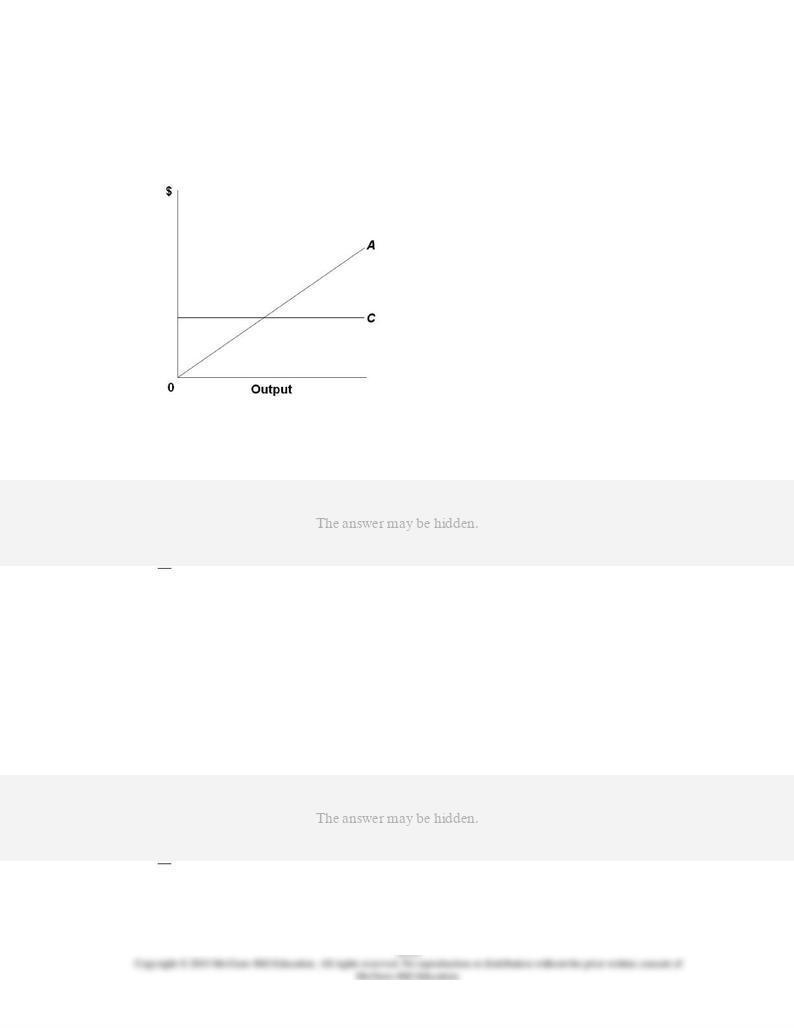
Difficulty: 2 Medium
Learning Objective: 10-03 Explain how demand is seen by a purely competitive seller.
Topic: Demand as seen by a purely competitive seller
Type: Graph
29.
Refer to the diagram, which pertains to a purely competitive firm. Curve
C
represents:
AACSB: Reflective Thinking
Blooms: Understand
Difficulty: 2 Medium
Learning Objective: 10-03 Explain how demand is seen by a purely competitive seller.
Topic: Demand as seen by a purely competitive seller
Type: Graph
30.
Marginal revenue is the:
AACSB: Analytic
Accessibility: Keyboard Navigation

Blooms: Remember
Difficulty: 1 Easy
Learning Objective: 10-03 Explain how demand is seen by a purely competitive seller.
Topic: Demand as seen by a purely competitive seller
31.
Firms seek to maximize:
AACSB: Reflective Thinking
Accessibility: Keyboard Navigation
Blooms: Remember
Difficulty: 1 Easy
Learning Objective: 10-04 Convey how purely competitive firms can use the total-revenue-total-cost approach to
maximize profits or minimize losses in the short run.
Topic: Profit maximization in the short run: total-revenue-total-cost approach
32.
A competitive firm in the short run can determine the profit-maximizing (or loss-
minimizing) output by equating:
AACSB: Reflective Thinking
Accessibility: Keyboard Navigation
Blooms: Understand
Difficulty: 2 Medium
Learning Objective: 10-05 Explain how purely competitive firms can use the marginal-revenue-marginal-cost approach to
maximize profits or minimize losses in the short run.
Topic: Profit maximization in the short run: marginal-revenue-marginal-cost approach

33.
In the short run, a purely competitive firm that seeks to maximize profit will produce:
AACSB: Reflective Thinking
Accessibility: Keyboard Navigation
Blooms: Understand
Difficulty: 2 Medium
Learning Objective: 10-04 Convey how purely competitive firms can use the total-revenue-total-cost approach to
maximize profits or minimize losses in the short run.
Topic: Profit maximization in the short run: total-revenue-total-cost approach
34.
Refer to the short-run data. The profit-maximizing output for this firm is:
AACSB: Analytic
Blooms: Apply
Difficulty: 2 Medium
Learning Objective: 10-04 Convey how purely competitive firms can use the total-revenue-total-cost approach to
maximize profits or minimize losses in the short run.

Topic: Profit maximization in the short run: total-revenue-total-cost approach
Type: Graph
35.
Refer to the short-run data. Which of the following is correct?
AACSB: Analytic
Blooms: Apply
Difficulty: 2 Medium
Learning Objective: 10-04 Convey how purely competitive firms can use the total-revenue-total-cost approach to
maximize profits or minimize losses in the short run.
Topic: Profit maximization in the short run: total-revenue-total-cost approach
Type: Graph
36.
A competitive firm will maximize profits at that output at which:
AACSB: Analytic
Accessibility: Keyboard Navigation

Blooms: Understand
Difficulty: 2 Medium
Learning Objective: 10-04 Convey how purely competitive firms can use the total-revenue-total-cost approach to
maximize profits or minimize losses in the short run.
Topic: Profit maximization in the short run: total-revenue-total-cost approach
37.
Curve (1) in the diagram is a purely competitive firm's:
AACSB: Reflective Thinking
Blooms: Apply
Difficulty: 2 Medium
Learning Objective: 10-04 Convey how purely competitive firms can use the total-revenue-total-cost approach to
maximize profits or minimize losses in the short run.
Topic: Profit maximization in the short run: total-revenue-total-cost approach
Type: Graph
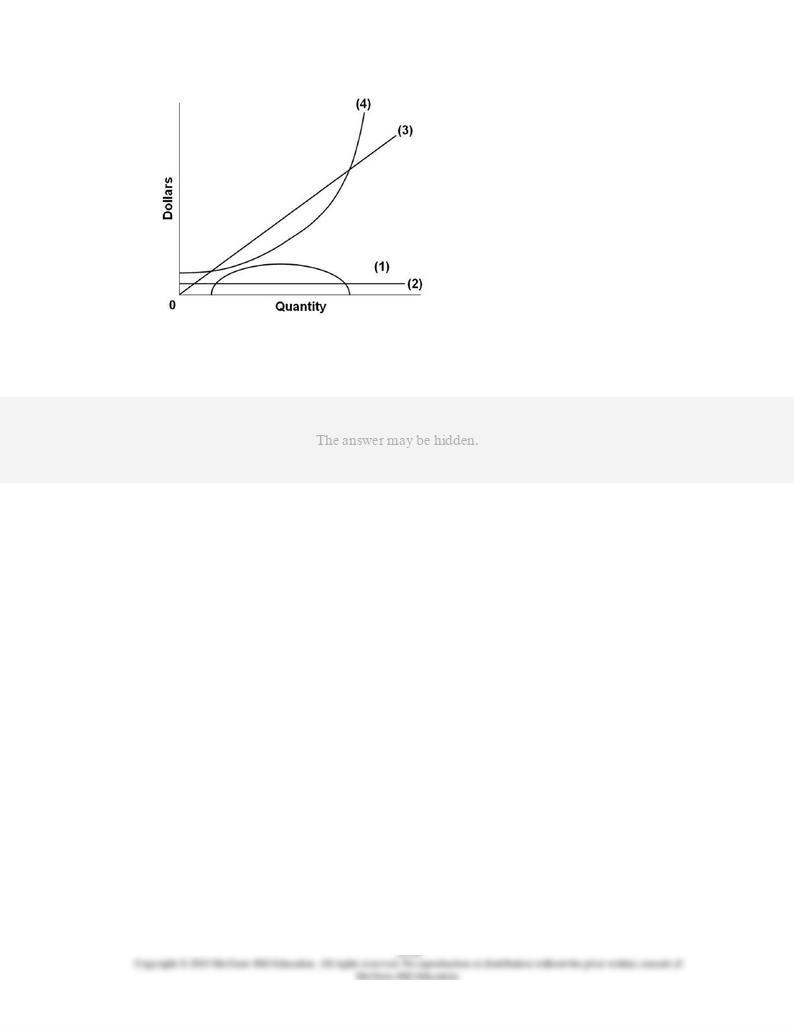
38.
Curve (2) in the diagram is a purely competitive firm's:
AACSB: Reflective Thinking
Blooms: Apply
Difficulty: 2 Medium
Learning Objective: 10-04 Convey how purely competitive firms can use the total-revenue-total-cost approach to
maximize profits or minimize losses in the short run.
Topic: Profit maximization in the short run: total-revenue-total-cost approach
Type: Graph

39.
Curve (3) in the diagram is a purely competitive firm's:
AACSB: Reflective Thinking
Blooms: Apply
Difficulty: 2 Medium
Learning Objective: 10-04 Convey how purely competitive firms can use the total-revenue-total-cost approach to
maximize profits or minimize losses in the short run.
Topic: Profit maximization in the short run: total-revenue-total-cost approach
Type: Graph
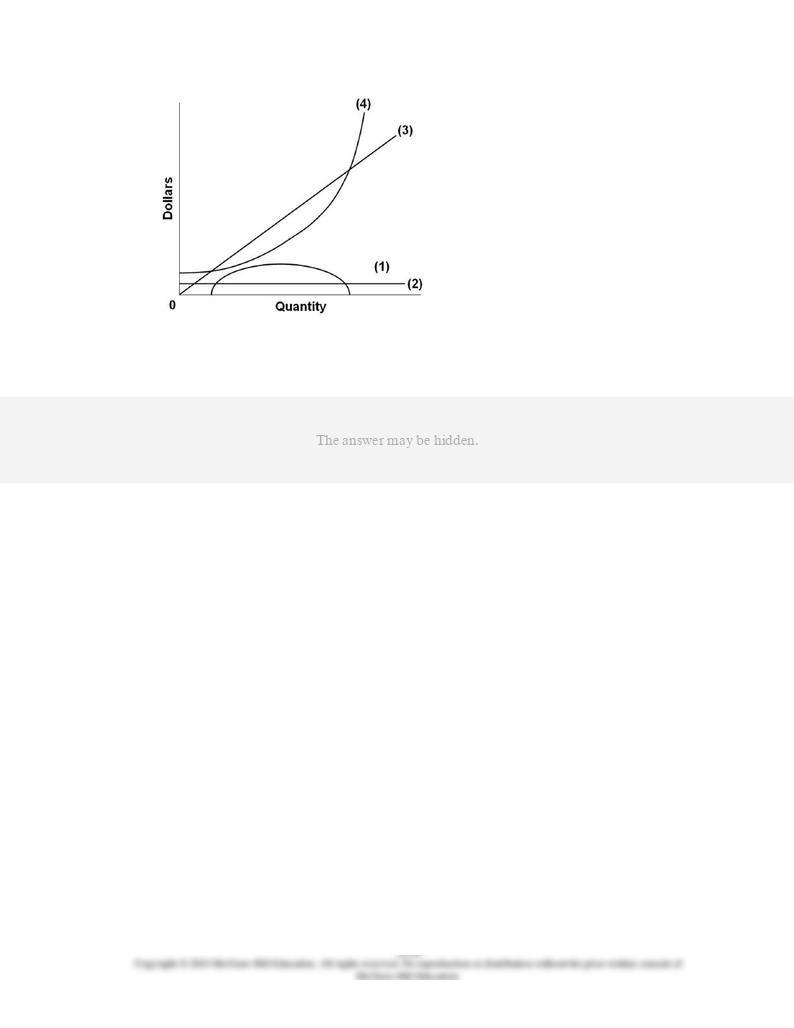
40.
Curve (4) in the diagram is a purely competitive firm's:
AACSB: Reflective Thinking
Blooms: Apply
Difficulty: 2 Medium
Learning Objective: 10-04 Convey how purely competitive firms can use the total-revenue-total-cost approach to
maximize profits or minimize losses in the short run.
Topic: Profit maximization in the short run: total-revenue-total-cost approach
Type: Graph
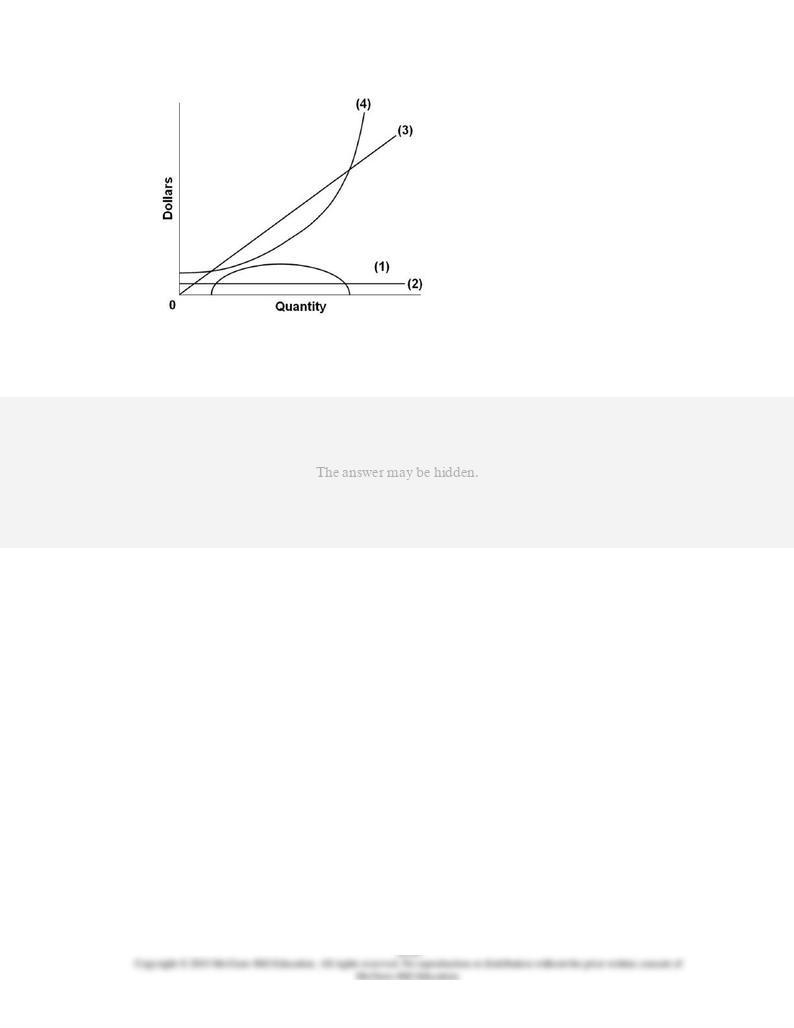
41.
Refer to the diagram. Other things equal, an increase of product price would be shown as:
AACSB: Analytic
Blooms: Analyze
Difficulty: 3 Hard
Learning Objective: 10-04 Convey how purely competitive firms can use the total-revenue-total-cost approach to
maximize profits or minimize losses in the short run.
Topic: Profit maximization in the short run: total-revenue-total-cost approach
Type: Graph

42.
The firm represented by the diagram would maximize its profit where:
AACSB: Reflective Thinking
Blooms: Apply
Difficulty: 2 Medium
Learning Objective: 10-04 Convey how purely competitive firms can use the total-revenue-total-cost approach to
maximize profits or minimize losses in the short run.
Topic: Profit maximization in the short run: total-revenue-total-cost approach
Type: Graph
43.
A firm reaches a
break-even
point
(normal profit position) where:
AACSB: Analytic
Accessibility: Keyboard Navigation
Blooms: Remember
Difficulty: 1 Easy
Learning Objective: 10-04 Convey how purely competitive firms can use the total-revenue-total-cost approach to
maximize profits or minimize losses in the short run.

Topic: Profit maximization in the short run: total-revenue-total-cost approach
44.
The MR = MC rule applies:
AACSB: Reflective Thinking
Accessibility: Keyboard Navigation
Blooms: Remember
Difficulty: 1 Easy
Learning Objective: 10-05 Explain how purely competitive firms can use the marginal-revenue-marginal-cost approach to
maximize profits or minimize losses in the short run.
Topic: Profit maximization in the short run: marginal-revenue-marginal-cost approach
45.
When a firm is maximizing profit, it will necessarily be:
AACSB: Reflective Thinking
Accessibility: Keyboard Navigation
Blooms: Understand
Difficulty: 2 Medium
Learning Objective: 10-04 Convey how purely competitive firms can use the total-revenue-total-cost approach to
maximize profits or minimize losses in the short run.
Topic: Profit maximization in the short run: total-revenue-total-cost approach

46.
The MR = MC rule can be restated for a purely competitive seller as
P
= MC because:
AACSB: Analytic
Accessibility: Keyboard Navigation
Blooms: Understand
Difficulty: 2 Medium
Learning Objective: 10-05 Explain how purely competitive firms can use the marginal-revenue-marginal-cost approach to
maximize profits or minimize losses in the short run.
Topic: Profit maximization in the short run: marginal-revenue-marginal-cost approach
47.
In the short run, the individual competitive firm's supply curve is that segment of the:
AACSB: Analytic
Accessibility: Keyboard Navigation
Blooms: Remember
Difficulty: 1 Easy
Learning Objective: 10-06 Explain why a competitive firm's marginal cost curve is the same as its supply curve.
Topic: Marginal cost and short-run supply

48.
Which of the following is
not
a valid generalization concerning the relationship between
price and costs for a purely competitive seller in the short run?
AACSB: Reflective Thinking
Accessibility: Keyboard Navigation
Blooms: Understand
Difficulty: 2 Medium
Learning Objective: 10-06 Explain why a competitive firm's marginal cost curve is the same as its supply curve.
Topic: Marginal cost and short-run supply
49.
Assume the XYZ Corporation is producing 20 units of output. It is selling this output in a
purely competitive market at $10 per unit. Its total fixed costs are $100 and its average
variable cost is $3 at 20 units of output. This corporation:
AACSB: Analytic
Accessibility: Keyboard Navigation
Blooms: Apply
Difficulty: 2 Medium
Learning Objective: 10-05 Explain how purely competitive firms can use the marginal-revenue-marginal-cost approach to
maximize profits or minimize losses in the short run.
Topic: Profit maximization in the short run: marginal-revenue-marginal-cost approach

50.
A purely competitive firm's short-run supply curve is:
AACSB: Analytic
Accessibility: Keyboard Navigation
Blooms: Remember
Difficulty: 1 Easy
Learning Objective: 10-06 Explain why a competitive firm's marginal cost curve is the same as its supply curve.
Topic: Marginal cost and short-run supply
51.
Suppose you find that the price of your product is less than minimum AVC. You should:
AACSB: Reflective Thinking
Accessibility: Keyboard Navigation
Blooms: Analyze
Difficulty: 3 Hard
Learning Objective: 10-05 Explain how purely competitive firms can use the marginal-revenue-marginal-cost approach to
maximize profits or minimize losses in the short run.
Topic: Profit maximization in the short run: marginal-revenue-marginal-cost approach

52.
If a purely competitive firm shuts down in the short run:
AACSB: Reflective Thinking
Accessibility: Keyboard Navigation
Blooms: Understand
Difficulty: 2 Medium
Learning Objective: 10-05 Explain how purely competitive firms can use the marginal-revenue-marginal-cost approach to
maximize profits or minimize losses in the short run.
Topic: Profit maximization in the short run: marginal-revenue-marginal-cost approach
53.
A purely competitive firm should produce in the short run if its total revenue is sufficient to
cover its:
AACSB: Reflective Thinking
Accessibility: Keyboard Navigation
Blooms: Understand
Difficulty: 2 Medium
Learning Objective: 10-05 Explain how purely competitive firms can use the marginal-revenue-marginal-cost approach to
maximize profits or minimize losses in the short run.
Topic: Profit maximization in the short run: marginal-revenue-marginal-cost approach

54.
Answer the question on the basis of the following data confronting a firm:
Refer to the data. This firm is selling its output in a(n):
AACSB: Reflective Thinking
Blooms: Apply
Difficulty: 2 Medium
Learning Objective: 10-05 Explain how purely competitive firms can use the marginal-revenue-marginal-cost approach to
maximize profits or minimize losses in the short run.
Topic: Profit maximization in the short run: marginal-revenue-marginal-cost approach
Type: Table
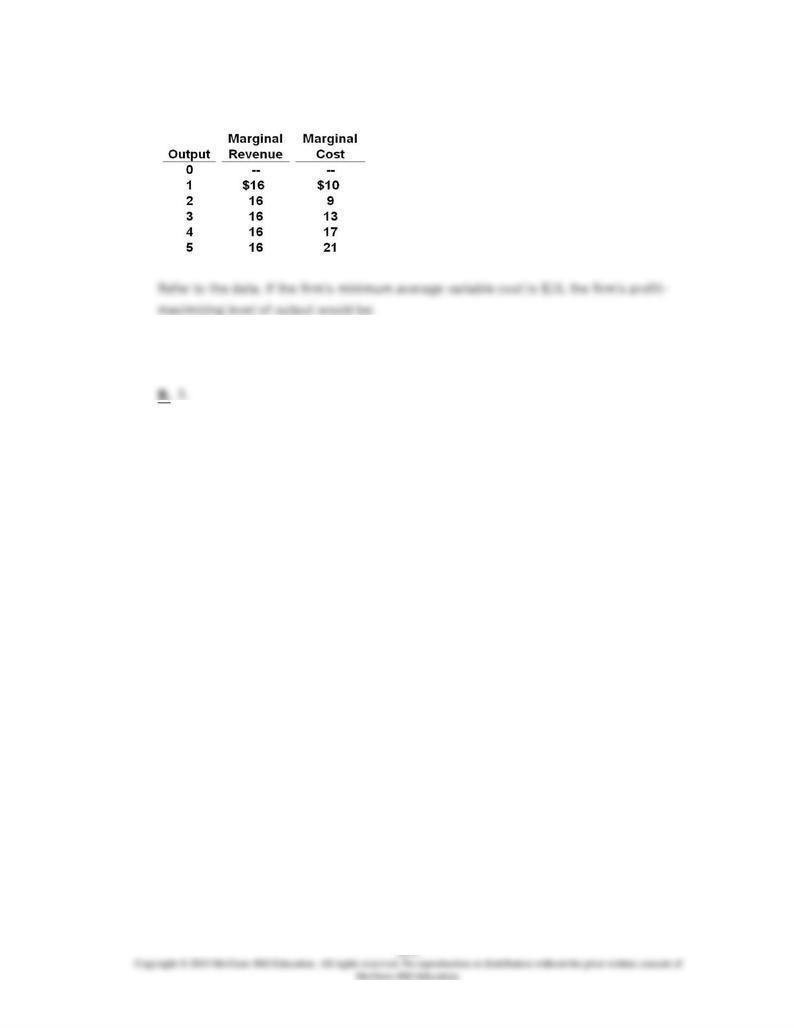
55.
Answer the question on the basis of the following data confronting a firm:
A.
2.
C.
4.
D.
5.
AACSB: Analytic
Blooms: Analyze
Difficulty: 3 Hard
Learning Objective: 10-05 Explain how purely competitive firms can use the marginal-revenue-marginal-cost approach to
maximize profits or minimize losses in the short run.
Topic: Profit maximization in the short run: marginal-revenue-marginal-cost approach
Type: Table

56.
Answer the question on the basis of the following data confronting a firm:
Refer to the data. At the profit-maximizing output, the firm's total revenue is:
AACSB: Analytic
Blooms: Analyze
Difficulty: 3 Hard
Learning Objective: 10-05 Explain how purely competitive firms can use the marginal-revenue-marginal-cost approach to
maximize profits or minimize losses in the short run.
Topic: Profit maximization in the short run: marginal-revenue-marginal-cost approach
Type: Table

57.
Answer the question on the basis of the following data confronting a firm:
Refer to the data. Assuming total fixed costs equal to zero, the firm's:
AACSB: Analytic
Blooms: Analyze
Difficulty: 3 Hard
Learning Objective: 10-05 Explain how purely competitive firms can use the marginal-revenue-marginal-cost approach to
maximize profits or minimize losses in the short run.
Topic: Profit maximization in the short run: marginal-revenue-marginal-cost approach
Type: Table
58.
In the short run, a purely competitive firm will always make an economic profit if:
AACSB: Reflective Thinking
Accessibility: Keyboard Navigation
Blooms: Understand
Difficulty: 2 Medium
Learning Objective: 10-05 Explain how purely competitive firms can use the marginal-revenue-marginal-cost approach to
maximize profits or minimize losses in the short run.
Topic: Profit maximization in the short run: marginal-revenue-marginal-cost approach

59.
Suppose that at 500 units of output marginal revenue is equal to marginal cost. The firm is
selling its output at $5 per unit and average total cost at 500 units of output is $6. On the
basis of this information, we:
AACSB: Analytic
Accessibility: Keyboard Navigation
Blooms: Analyze
Difficulty: 3 Hard
Learning Objective: 10-05 Explain how purely competitive firms can use the marginal-revenue-marginal-cost approach to
maximize profits or minimize losses in the short run.
Topic: Profit maximization in the short run: marginal-revenue-marginal-cost approach
60.
If a firm is confronted with economic losses in the short run, it will decide whether or not
to produce by comparing:
AACSB: Reflective Thinking
Accessibility: Keyboard Navigation
Blooms: Understand
Difficulty: 2 Medium
Learning Objective: 10-05 Explain how purely competitive firms can use the marginal-revenue-marginal-cost approach to
maximize profits or minimize losses in the short run.
Topic: Profit maximization in the short run: marginal-revenue-marginal-cost approach

61.
A firm finds that at its MR = MC output, its TC = $1,000, TVC = $800, TFC = $200, and
total revenue is $900. This firm should:
AACSB: Analytic
Accessibility: Keyboard Navigation
Blooms: Analyze
Difficulty: 3 Hard
Learning Objective: 10-05 Explain how purely competitive firms can use the marginal-revenue-marginal-cost approach to
maximize profits or minimize losses in the short run.
Topic: Profit maximization in the short run: marginal-revenue-marginal-cost approach
62.
The lowest point on a purely competitive firm's short-run supply curve corresponds to:
AACSB: Reflective Thinking
Accessibility: Keyboard Navigation
Blooms: Understand
Difficulty: 2 Medium
Learning Objective: 10-06 Explain why a competitive firm's marginal cost curve is the same as its supply curve.
Topic: Marginal cost and short-run supply
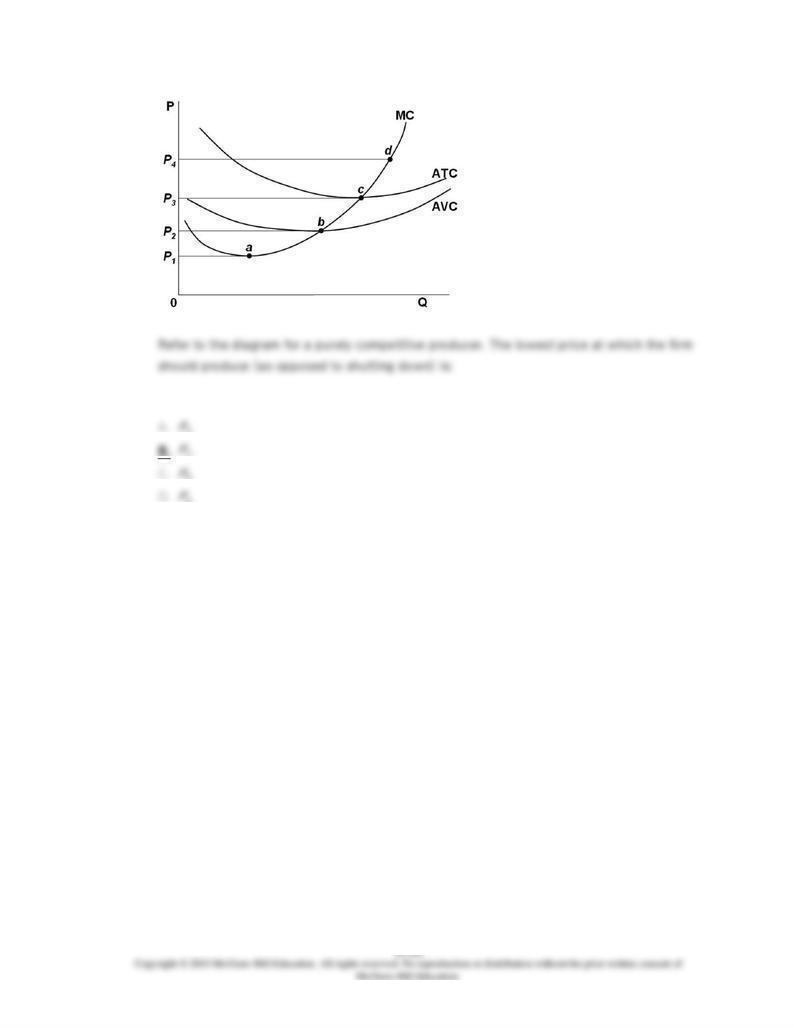
63.
1.
2.
3.
4.
AACSB: Reflective Thinking
Blooms: Analyze
Difficulty: 3 Hard
Learning Objective: 10-06 Explain why a competitive firm's marginal cost curve is the same as its supply curve.
Topic: Marginal cost and short-run supply
Type: Graph

64.
1.
3.
4.
2 and
3.
AACSB: Reflective Thinking
Blooms: Analyze
Difficulty: 3 Hard
Learning Objective: 10-05 Explain how purely competitive firms can use the marginal-revenue-marginal-cost approach to
maximize profits or minimize losses in the short run.
Topic: Profit maximization in the short run: marginal-revenue-marginal-cost approach
Type: Graph

65.
Refer to the diagram for a purely competitive producer. If product price is
P
3:
AACSB: Reflective Thinking
Blooms: Analyze
Difficulty: 3 Hard
Learning Objective: 10-05 Explain how purely competitive firms can use the marginal-revenue-marginal-cost approach to
maximize profits or minimize losses in the short run.
Topic: Profit maximization in the short run: marginal-revenue-marginal-cost approach
Type: Graph

66.
Refer to the diagram for a purely competitive producer. The firm's short-run supply curve
is:
AACSB: Reflective Thinking
Blooms: Apply
Difficulty: 2 Medium
Learning Objective: 10-06 Explain why a competitive firm's marginal cost curve is the same as its supply curve.
Topic: Marginal cost and short-run supply
Type: Graph
67.
The short-run supply curve of a purely competitive producer is based primarily on its:
AACSB: Reflective Thinking
Accessibility: Keyboard Navigation
Blooms: Understand
Difficulty: 2 Medium
Learning Objective: 10-06 Explain why a competitive firm's marginal cost curve is the same as its supply curve.
Topic: Marginal cost and short-run supply

68.
On a per unit basis, economic profit can be determined as the difference between:
AACSB: Reflective Thinking
Accessibility: Keyboard Navigation
Blooms: Understand
Difficulty: 2 Medium
Learning Objective: 10-05 Explain how purely competitive firms can use the marginal-revenue-marginal-cost approach to
maximize profits or minimize losses in the short run.
Topic: Profit maximization in the short run: marginal-revenue-marginal-cost approach
69.
In the short run, a purely competitive seller will shut down if:
AACSB: Reflective Thinking
Accessibility: Keyboard Navigation
Blooms: Understand
Difficulty: 2 Medium
Learning Objective: 10-05 Explain how purely competitive firms can use the marginal-revenue-marginal-cost approach to
maximize profits or minimize losses in the short run.
Topic: Profit maximization in the short run: marginal-revenue-marginal-cost approach
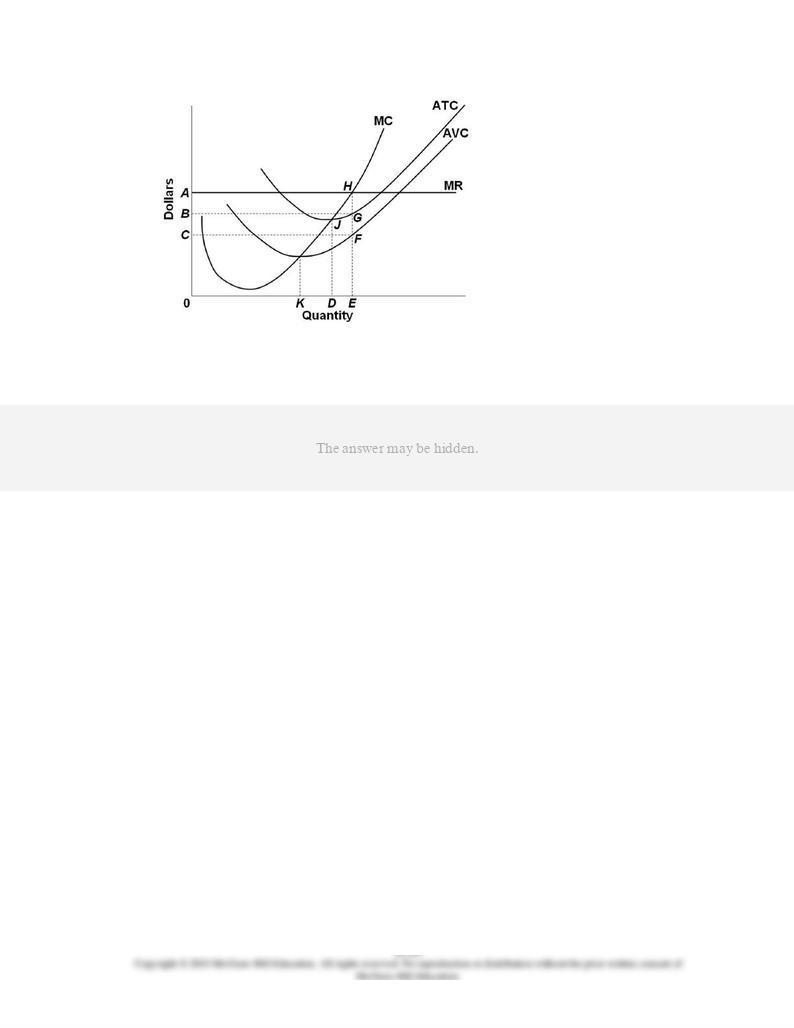
70.
Refer to the diagram. To maximize profit or minimize losses, this firm will produce:
AACSB: Reflective Thinking
Blooms: Analyze
Difficulty: 3 Hard
Learning Objective: 10-05 Explain how purely competitive firms can use the marginal-revenue-marginal-cost approach to
maximize profits or minimize losses in the short run.
Topic: Profit maximization in the short run: marginal-revenue-marginal-cost approach
Type: Graph
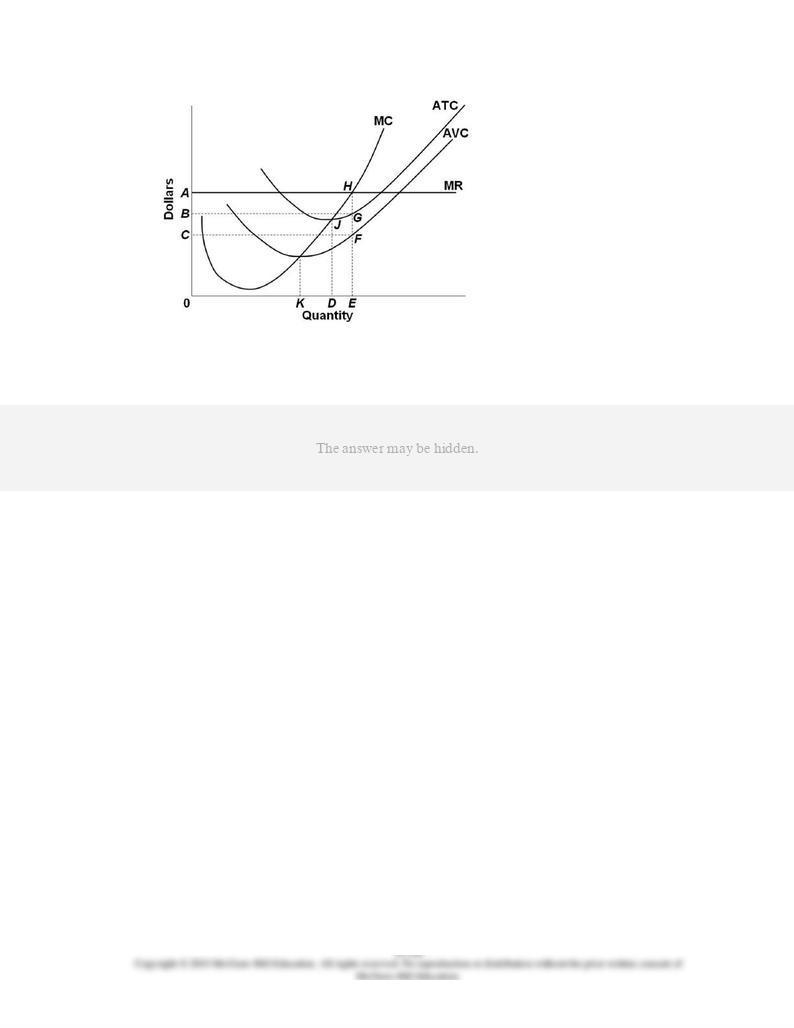
71.
Refer to the diagram. At the profit-maximizing output, total revenue will be:
AACSB: Reflective Thinking
Blooms: Analyze
Difficulty: 3 Hard
Learning Objective: 10-05 Explain how purely competitive firms can use the marginal-revenue-marginal-cost approach to
maximize profits or minimize losses in the short run.
Topic: Profit maximization in the short run: marginal-revenue-marginal-cost approach
Type: Graph
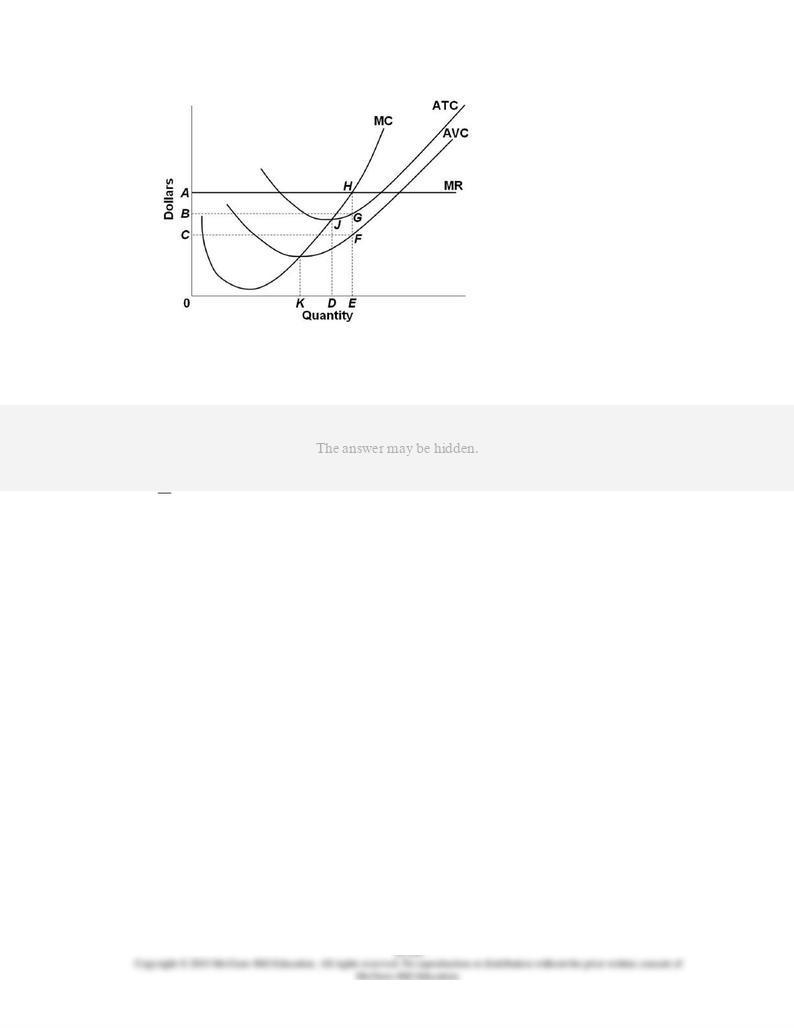
72.
Refer to the diagram. At the profit-maximizing output, total fixed cost is equal to:
AACSB: Reflective Thinking
Blooms: Analyze
Difficulty: 3 Hard
Learning Objective: 10-05 Explain how purely competitive firms can use the marginal-revenue-marginal-cost approach to
maximize profits or minimize losses in the short run.
Topic: Profit maximization in the short run: marginal-revenue-marginal-cost approach
Type: Graph

73.
Refer to the diagram. At the profit-maximizing output, total variable cost is equal to:
AACSB: Reflective Thinking
Blooms: Analyze
Difficulty: 3 Hard
Learning Objective: 10-05 Explain how purely competitive firms can use the marginal-revenue-marginal-cost approach to
maximize profits or minimize losses in the short run.
Topic: Profit maximization in the short run: marginal-revenue-marginal-cost approach
Type: Graph
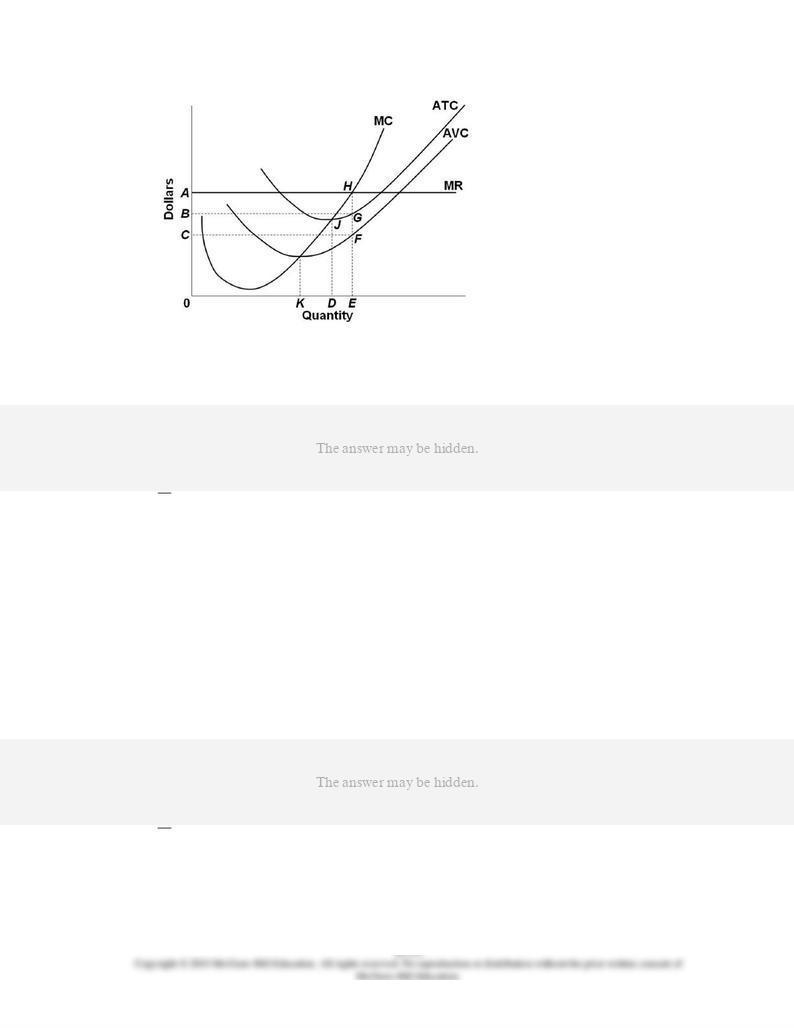
74.
Refer to the diagram. At the profit-maximizing output, the firm will realize:
AACSB: Reflective Thinking
Blooms: Analyze
Difficulty: 3 Hard
Learning Objective: 10-05 Explain how purely competitive firms can use the marginal-revenue-marginal-cost approach to
maximize profits or minimize losses in the short run.
Topic: Profit maximization in the short run: marginal-revenue-marginal-cost approach
Type: Graph
75.
If a purely competitive firm is producing at some level less than the profit-maximizing
output, then:
AACSB: Reflective Thinking
Accessibility: Keyboard Navigation
Blooms: Understand
Difficulty: 2 Medium
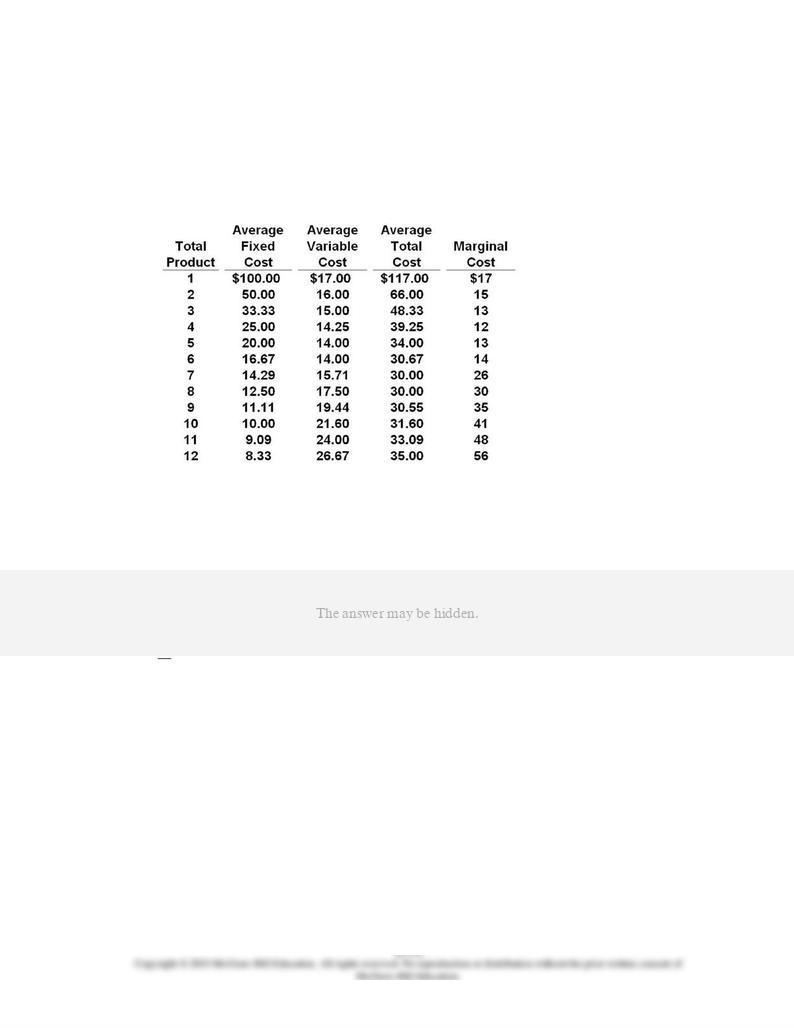
Learning Objective: 10-05 Explain how purely competitive firms can use the marginal-revenue-marginal-cost approach to
maximize profits or minimize losses in the short run.
Topic: Profit maximization in the short run: marginal-revenue-marginal-cost approach
76.
Answer the question on the basis of the following cost data for a firm that is selling in a
purely competitive market:
Refer to the data. If the market price for the firm's product is $12, the competitive firm
should produce:
AACSB: Analytic
Blooms: Analyze
Difficulty: 3 Hard
Learning Objective: 10-05 Explain how purely competitive firms can use the marginal-revenue-marginal-cost approach to
maximize profits or minimize losses in the short run.
Topic: Profit maximization in the short run: marginal-revenue-marginal-cost approach
Type: Table
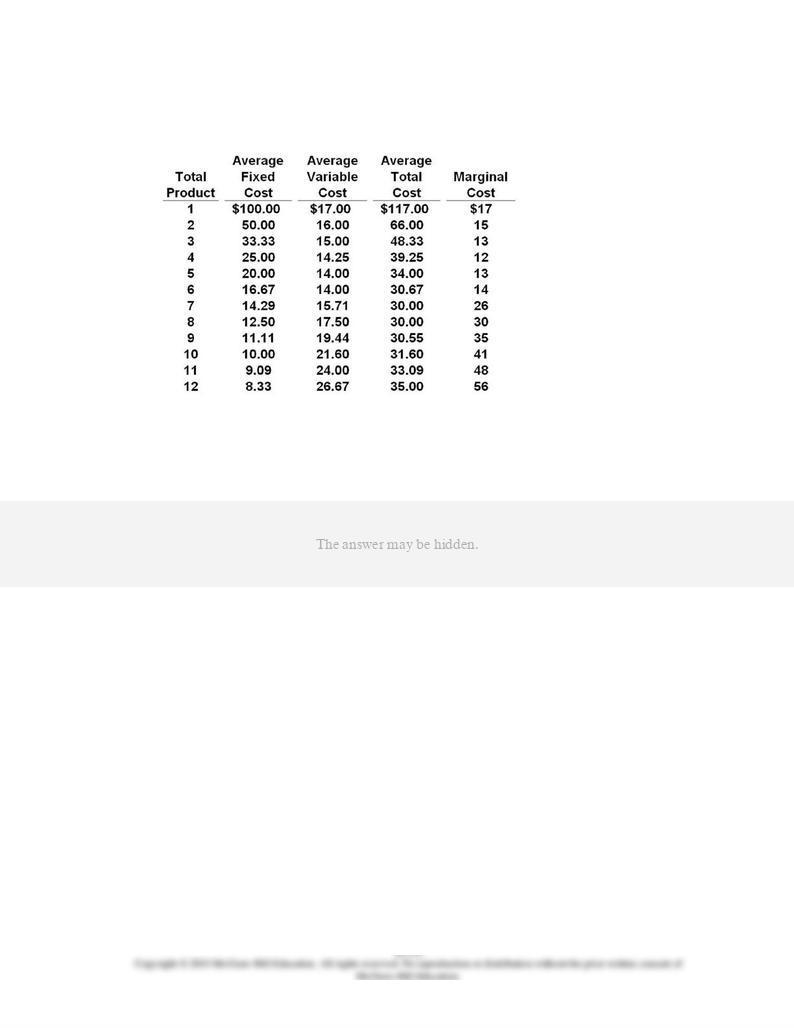
77.
Answer the question on the basis of the following cost data for a firm that is selling in a
purely competitive market:
Refer to the data. If the market price for the firm's product is $32, the competitive firm will
produce:
AACSB: Analytic
Blooms: Analyze
Difficulty: 3 Hard
Learning Objective: 10-05 Explain how purely competitive firms can use the marginal-revenue-marginal-cost approach to
maximize profits or minimize losses in the short run.
Topic: Profit maximization in the short run: marginal-revenue-marginal-cost approach
Type: Table

78.
Answer the question on the basis of the following cost data for a firm that is selling in a
purely competitive market:
Refer to the data. If the market price for the firm's product is $28, the competitive firm
will:
AACSB: Analytic
Blooms: Analyze
Difficulty: 3 Hard
Learning Objective: 10-05 Explain how purely competitive firms can use the marginal-revenue-marginal-cost approach to
maximize profits or minimize losses in the short run.
Topic: Profit maximization in the short run: marginal-revenue-marginal-cost approach
Type: Table
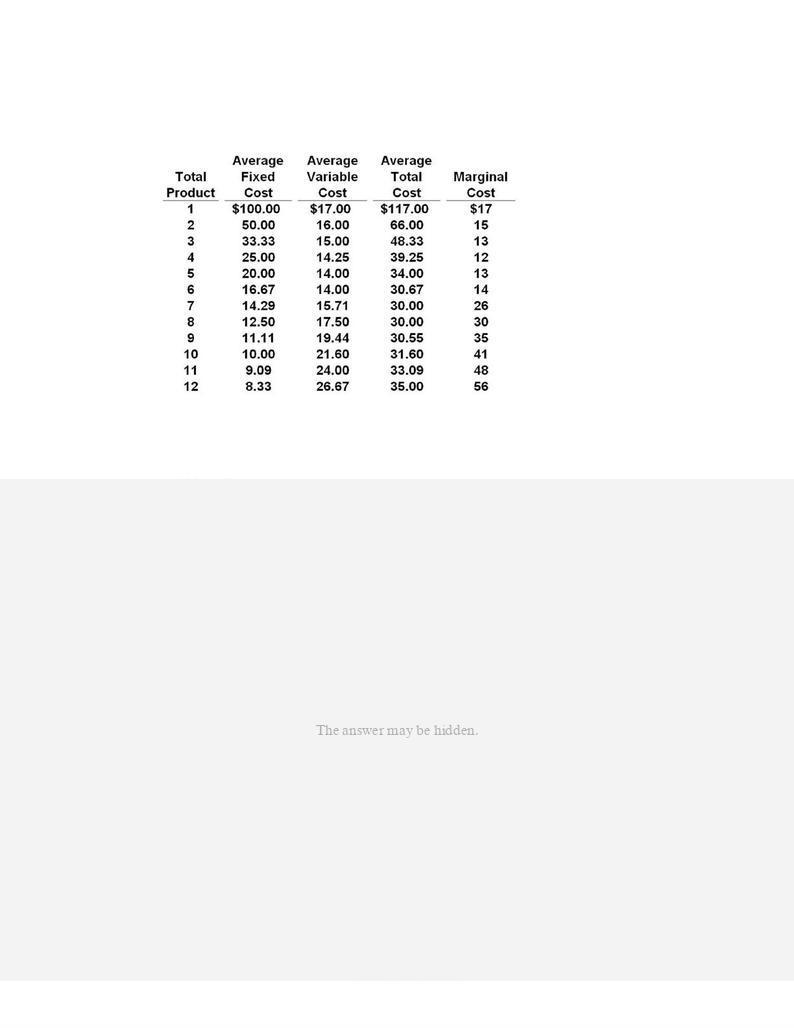
79.
Answer the question on the basis of the following cost data for a firm that is selling in a
purely competitive market:
Refer to the data. Which of the following is the firm's short-run supply schedule?
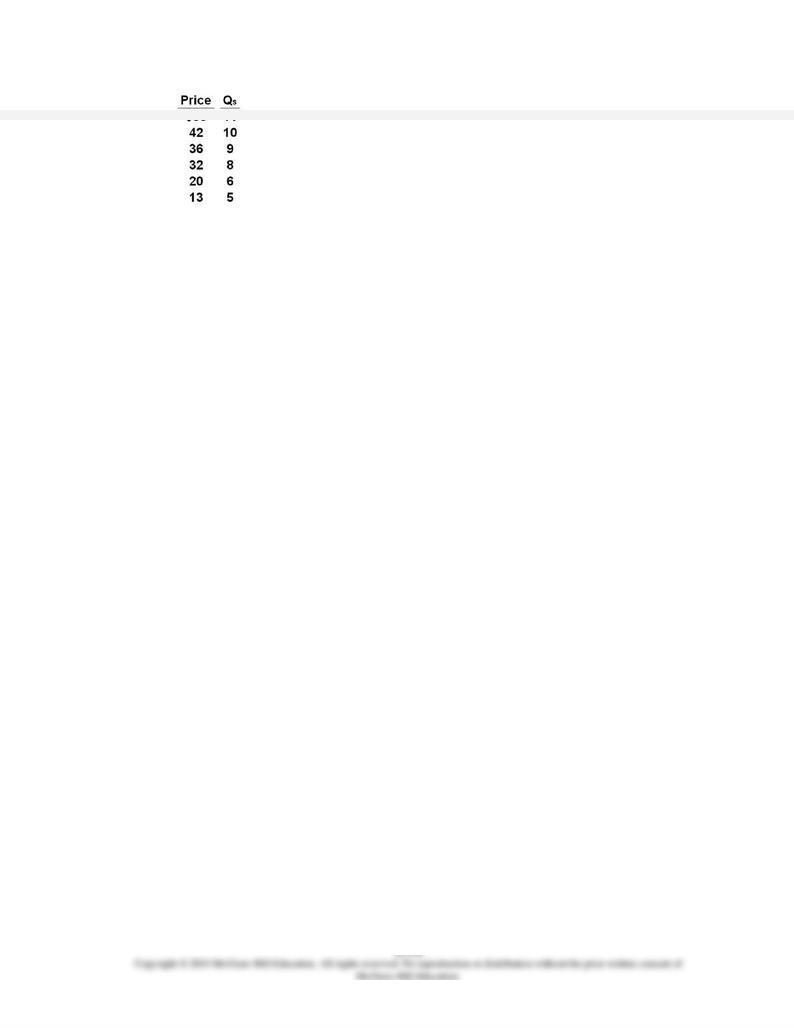
D.
AACSB: Analytic
Blooms: Analyze
Difficulty: 3 Hard
Learning Objective: 10-06 Explain why a competitive firm's marginal cost curve is the same as its supply curve.
Topic: Marginal cost and short-run supply
Type: Table

80.
Answer the question on the basis of the following cost data for a firm that is selling in a
purely competitive market:
Refer to the data. If there were 1,000 identical firms in this industry and total or market
demand is as shown below, equilibrium price will be:
AACSB: Analytic
Blooms: Analyze
Difficulty: 3 Hard
Learning Objective: 10-06 Explain why a competitive firm's marginal cost curve is the same as its supply curve.
Topic: Marginal cost and short-run supply
Type: Table
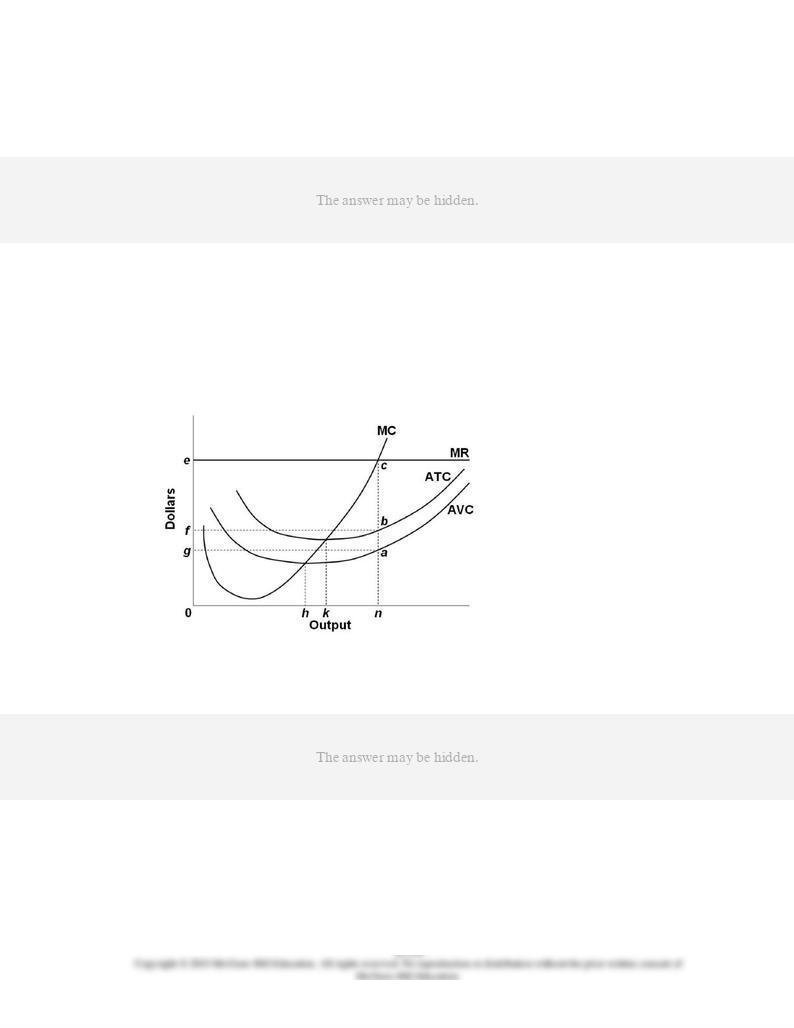
81.
If at the MC = MR output, AVC exceeds price:
AACSB: Reflective Thinking
Accessibility: Keyboard Navigation
Blooms: Understand
Difficulty: 2 Medium
Learning Objective: 10-05 Explain how purely competitive firms can use the marginal-revenue-marginal-cost approach to
maximize profits or minimize losses in the short run.
Topic: Profit maximization in the short run: marginal-revenue-marginal-cost approach
82.
Refer to the diagram. The profit-maximizing output:
AACSB: Reflective Thinking
Blooms: Analyze
Difficulty: 3 Hard
Learning Objective: 10-05 Explain how purely competitive firms can use the marginal-revenue-marginal-cost approach to
maximize profits or minimize losses in the short run.
Topic: Profit maximization in the short run: marginal-revenue-marginal-cost approach
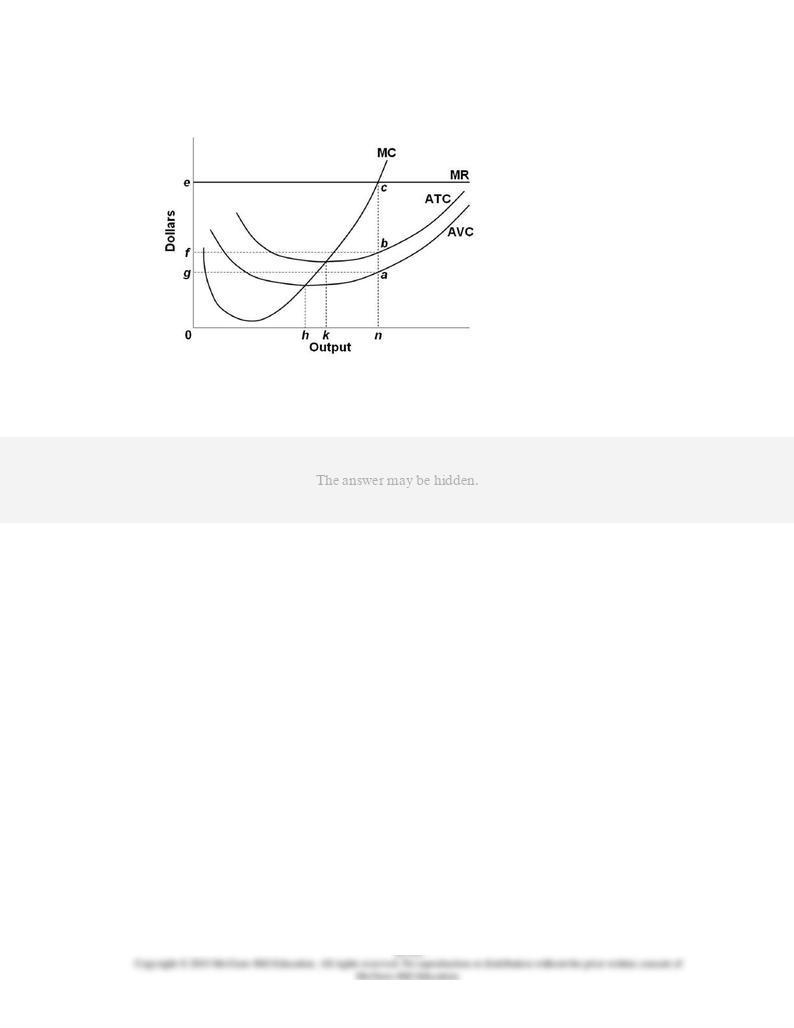
Type: Graph
83.
Refer to the diagram. At the profit-maximizing output, total profit is:
AACSB: Reflective Thinking
Blooms: Analyze
Difficulty: 3 Hard
Learning Objective: 10-05 Explain how purely competitive firms can use the marginal-revenue-marginal-cost approach to
maximize profits or minimize losses in the short run.
Topic: Profit maximization in the short run: marginal-revenue-marginal-cost approach
Type: Graph
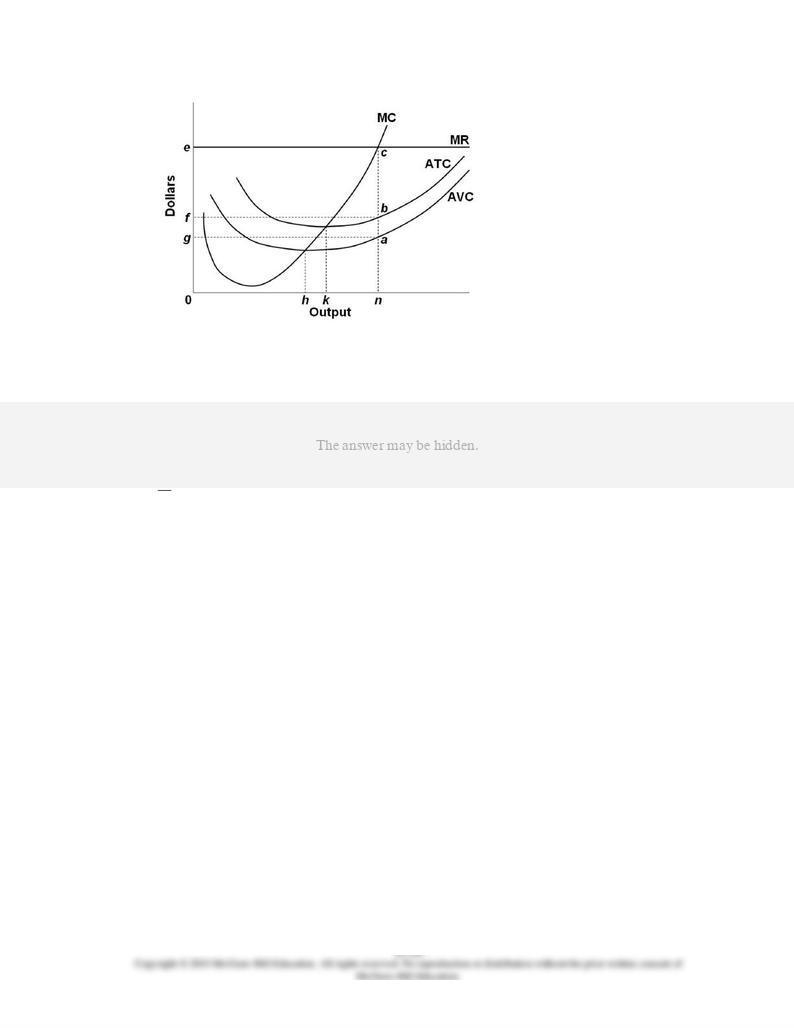
84.
Refer to the diagram. The short-run supply curve for this firm is the:
AACSB: Reflective Thinking
Blooms: Apply
Difficulty: 2 Medium
Learning Objective: 10-06 Explain why a competitive firm's marginal cost curve is the same as its supply curve.
Topic: Marginal cost and short-run supply
Type: Graph

85.
Refer to the diagram. This firm is selling its product in a(n):
AACSB: Reflective Thinking
Blooms: Apply
Difficulty: 2 Medium
Learning Objective: 10-05 Explain how purely competitive firms can use the marginal-revenue-marginal-cost approach to
maximize profits or minimize losses in the short run.
Topic: Profit maximization in the short run: marginal-revenue-marginal-cost approach
Type: Graph
86.
In the short run, a purely competitive seller will shut down if product price:
AACSB: Reflective Thinking
Accessibility: Keyboard Navigation
Blooms: Understand
Difficulty: 2 Medium
Learning Objective: 10-05 Explain how purely competitive firms can use the marginal-revenue-marginal-cost approach to
maximize profits or minimize losses in the short run.

Topic: Profit maximization in the short run: marginal-revenue-marginal-cost approach
87.
The short-run supply curve for a purely competitive industry can be found by:
AACSB: Analytic
Accessibility: Keyboard Navigation
Blooms: Understand
Difficulty: 2 Medium
Learning Objective: 10-06 Explain why a competitive firm's marginal cost curve is the same as its supply curve.
Topic: Marginal cost and short-run supply
88.
DASH Airlines is considering the addition of a flight from Red Cloud to David City. The
total cost of the flight would be $1,100, of which $800 are fixed costs already incurred.
Expected revenues from the flight are $600. DASH should:
AACSB: Analytic
Accessibility: Keyboard Navigation
Blooms: Analyze
Difficulty: 3 Hard
Learning Objective: 10-05 Explain how purely competitive firms can use the marginal-revenue-marginal-cost approach to
maximize profits or minimize losses in the short run.
Topic: Profit maximization in the short run: marginal-revenue-marginal-cost approach

89.
In contrast to American firms, Japanese firms frequently make lifetime employment
commitments to their workers and agree not to lay them off when product demand is
weak. Other things being equal, we would expect Japanese firms to:
AACSB: Reflective Thinking
Accessibility: Keyboard Navigation
Blooms: Evaluate
Difficulty: 3 Hard
Learning Objective: 10-05 Explain how purely competitive firms can use the marginal-revenue-marginal-cost approach to
maximize profits or minimize losses in the short run.
Topic: Profit maximization in the short run: marginal-revenue-marginal-cost approach
90.
Assume for a competitive firm that MC = AVC at $12, MC = ATC at $20, and MC = MR at
$16. This firm will:
AACSB: Analytic
Accessibility: Keyboard Navigation
Blooms: Analyze
Difficulty: 3 Hard
Learning Objective: 10-05 Explain how purely competitive firms can use the marginal-revenue-marginal-cost approach to
maximize profits or minimize losses in the short run.
Topic: Profit maximization in the short run: marginal-revenue-marginal-cost approach

91.
The principle that a firm should produce up to the point where the marginal revenue from
the sale of an extra unit of output is equal to the marginal cost of producing it is known as
the:
AACSB: Analytic
Accessibility: Keyboard Navigation
Blooms: Remember
Difficulty: 1 Easy
Learning Objective: 10-05 Explain how purely competitive firms can use the marginal-revenue-marginal-cost approach to
maximize profits or minimize losses in the short run.
Topic: Profit maximization in the short run: marginal-revenue-marginal-cost approach
92.
If a purely competitive firm is producing at the
P
= MC output and realizing an economic
profit, at that output:
AACSB: Reflective Thinking
Accessibility: Keyboard Navigation
Blooms: Understand
Difficulty: 2 Medium
Learning Objective: 10-05 Explain how purely competitive firms can use the marginal-revenue-marginal-cost approach to
maximize profits or minimize losses in the short run.
Topic: Profit maximization in the short run: marginal-revenue-marginal-cost approach

93.
If a profit-seeking competitive firm is producing its profit-maximizing output and its total
fixed costs fall by 25 percent, the firm should:
AACSB: Reflective Thinking
Accessibility: Keyboard Navigation
Blooms: Analyze
Difficulty: 3 Hard
Learning Objective: 10-05 Explain how purely competitive firms can use the marginal-revenue-marginal-cost approach to
maximize profits or minimize losses in the short run.
Topic: Profit maximization in the short run: marginal-revenue-marginal-cost approach
94.
Refer to the diagram. At
P
2, this firm will:
AACSB: Reflective Thinking
Blooms: Analyze
Difficulty: 3 Hard
Learning Objective: 10-05 Explain how purely competitive firms can use the marginal-revenue-marginal-cost approach to
maximize profits or minimize losses in the short run.
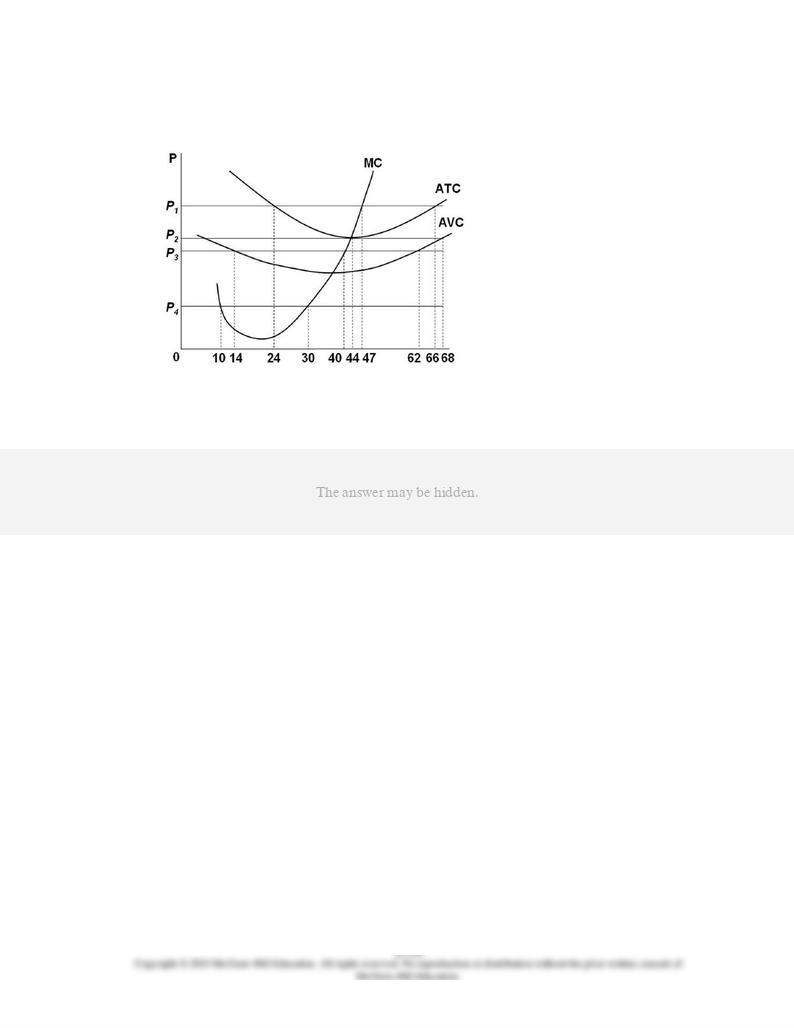
Topic: Profit maximization in the short run: marginal-revenue-marginal-cost approach
Type: Graph
95.
Refer to the diagram. At
P
1, this firm will produce:
AACSB: Reflective Thinking
Blooms: Analyze
Difficulty: 3 Hard
Learning Objective: 10-05 Explain how purely competitive firms can use the marginal-revenue-marginal-cost approach to
maximize profits or minimize losses in the short run.
Topic: Profit maximization in the short run: marginal-revenue-marginal-cost approach
Type: Graph
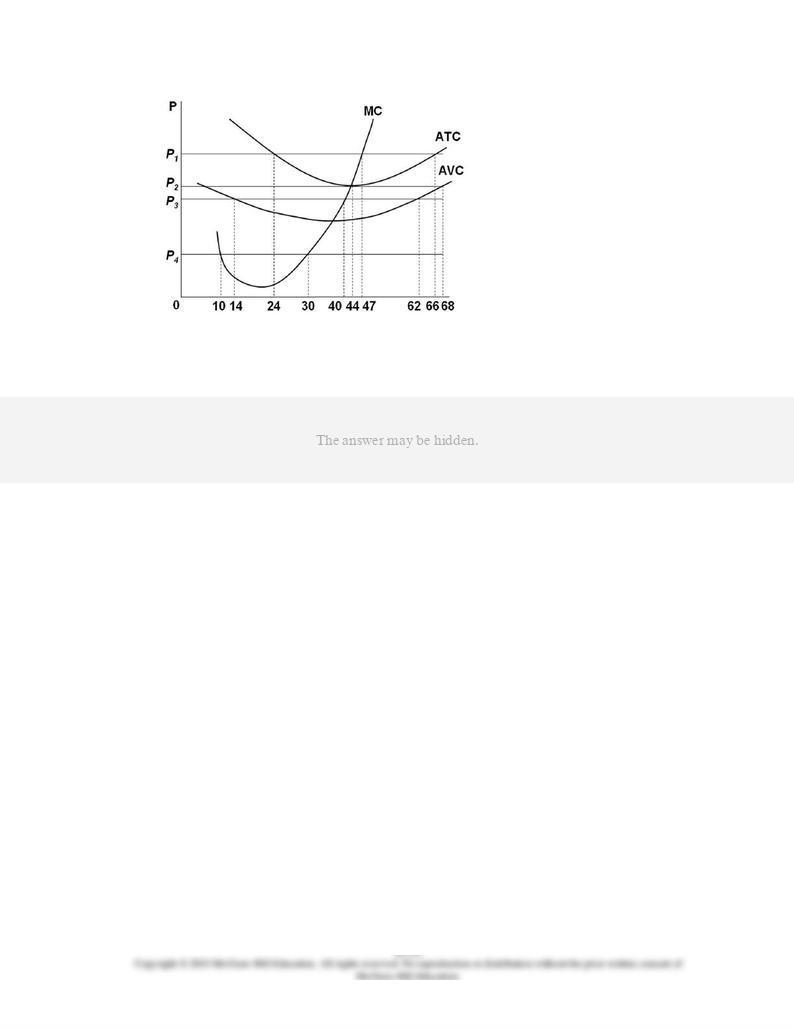
96.
Refer to the diagram. At
P
4, this firm will:
AACSB: Reflective Thinking
Blooms: Analyze
Difficulty: 3 Hard
Learning Objective: 10-05 Explain how purely competitive firms can use the marginal-revenue-marginal-cost approach to
maximize profits or minimize losses in the short run.
Topic: Profit maximization in the short run: marginal-revenue-marginal-cost approach
Type: Graph
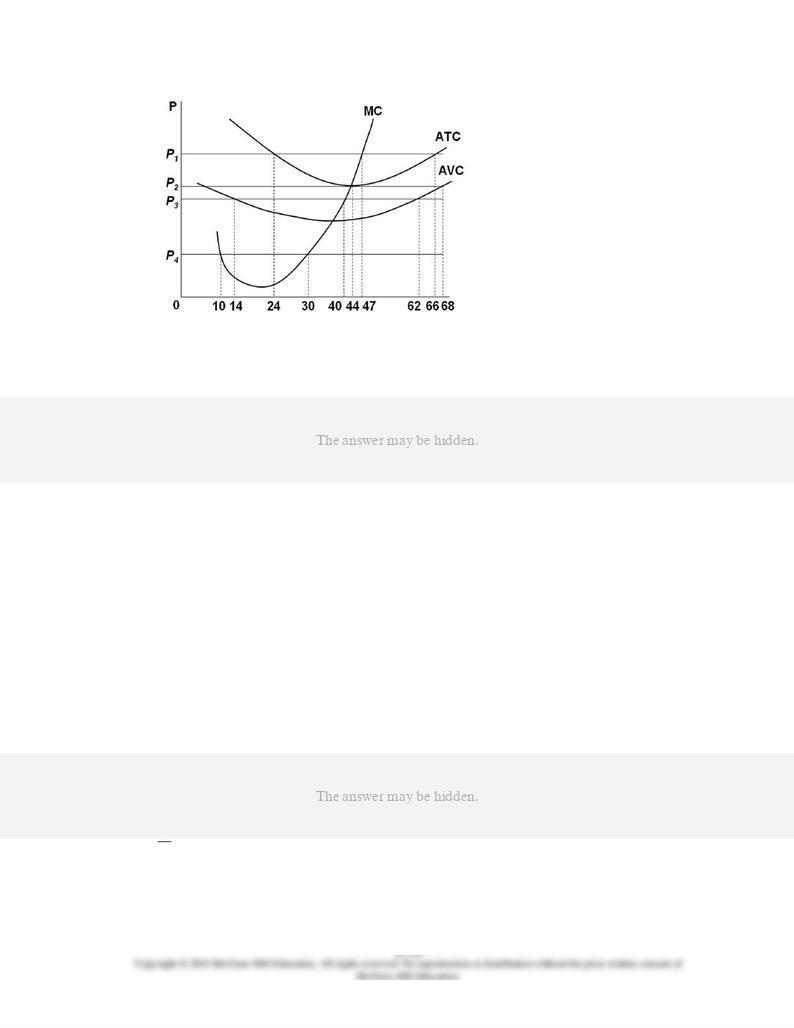
97.
Refer to the diagram. At
P
3, this firm will:
AACSB: Reflective Thinking
Blooms: Analyze
Difficulty: 3 Hard
Learning Objective: 10-05 Explain how purely competitive firms can use the marginal-revenue-marginal-cost approach to
maximize profits or minimize losses in the short run.
Topic: Profit maximization in the short run: marginal-revenue-marginal-cost approach
Type: Graph
98.
The Ajax Manufacturing Company is selling in a purely competitive market. Its output is
100 units, which sell at $4 each. At this level of output total cost is $600, total fixed cost is
$100, and marginal cost is $4. The firm should:
AACSB: Analytic
Accessibility: Keyboard Navigation
Blooms: Analyze
Difficulty: 3 Hard
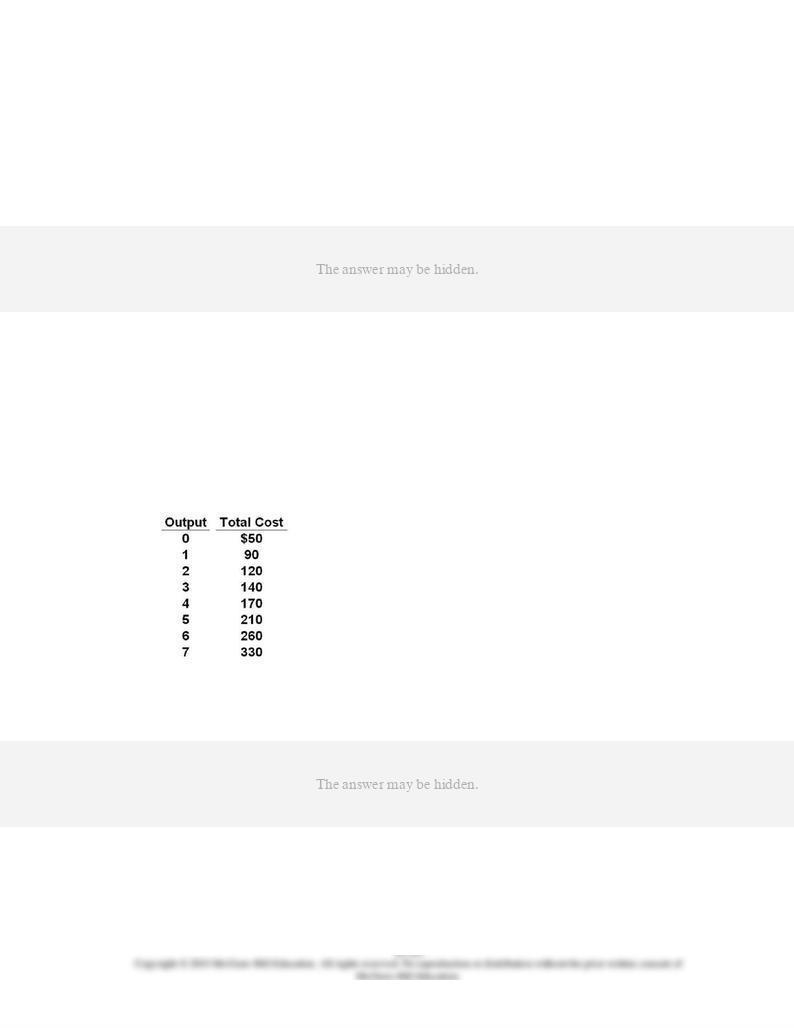
Learning Objective: 10-05 Explain how purely competitive firms can use the marginal-revenue-marginal-cost approach to
maximize profits or minimize losses in the short run.
Topic: Profit maximization in the short run: marginal-revenue-marginal-cost approach
99.
If a purely competitive firm is maximizing economic profit:
AACSB: Reflective Thinking
Accessibility: Keyboard Navigation
Blooms: Understand
Difficulty: 2 Medium
Learning Objective: 10-05 Explain how purely competitive firms can use the marginal-revenue-marginal-cost approach to
maximize profits or minimize losses in the short run.
Topic: Profit maximization in the short run: marginal-revenue-marginal-cost approach
100.
Answer the question on the basis of the following cost data for a purely competitive seller:
Refer to the data. If product price is $60, the firm will:
AACSB: Analytic
Blooms: Analyze
Difficulty: 3 Hard
Learning Objective: 10-05 Explain how purely competitive firms can use the marginal-revenue-marginal-cost approach to

maximize profits or minimize losses in the short run.
Topic: Profit maximization in the short run: marginal-revenue-marginal-cost approach
Type: Table
101.
Answer the question on the basis of the following cost data for a purely competitive seller:
Refer to the data. If product price is $45, the firm will:
AACSB: Analytic
Blooms: Analyze
Difficulty: 3 Hard
Learning Objective: 10-05 Explain how purely competitive firms can use the marginal-revenue-marginal-cost approach to
maximize profits or minimize losses in the short run.
Topic: Profit maximization in the short run: marginal-revenue-marginal-cost approach
Type: Table

102.
Answer the question on the basis of the following cost data for a purely competitive seller:
Refer to the data. If product price is $25, the firm will:
AACSB: Analytic
Blooms: Analyze
Difficulty: 3 Hard
Learning Objective: 10-05 Explain how purely competitive firms can use the marginal-revenue-marginal-cost approach to
maximize profits or minimize losses in the short run.
Topic: Profit maximization in the short run: marginal-revenue-marginal-cost approach
Type: Table
103.
Assume a purely competitive firm is selling 200 units of output at $3 each. At this output,
its total fixed cost is $100 and its total variable cost is $350. This firm:
AACSB: Analytic
Accessibility: Keyboard Navigation
Blooms: Analyze
Difficulty: 3 Hard
Learning Objective: 10-05 Explain how purely competitive firms can use the marginal-revenue-marginal-cost approach to
maximize profits or minimize losses in the short run.
Topic: Profit maximization in the short run: marginal-revenue-marginal-cost approach
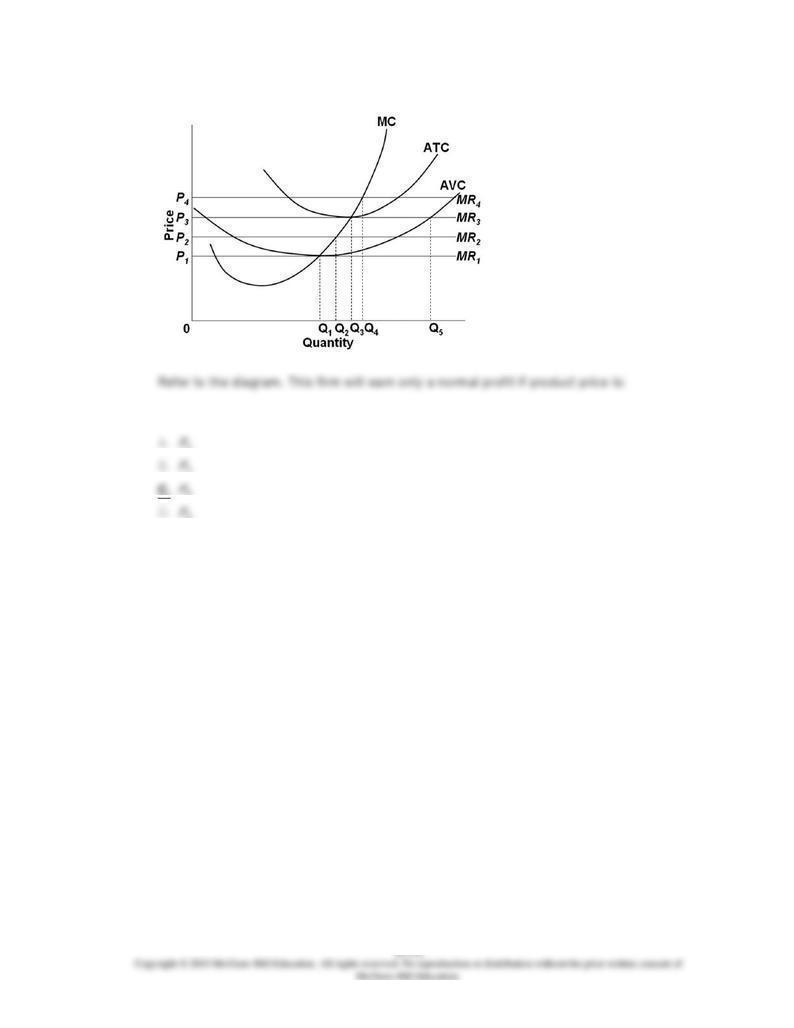
104.
1.
2.
3.
4.
AACSB: Reflective Thinking
Blooms: Apply
Difficulty: 2 Medium
Learning Objective: 10-05 Explain how purely competitive firms can use the marginal-revenue-marginal-cost approach to
maximize profits or minimize losses in the short run.
Topic: Profit maximization in the short run: marginal-revenue-marginal-cost approach
Type: Graph
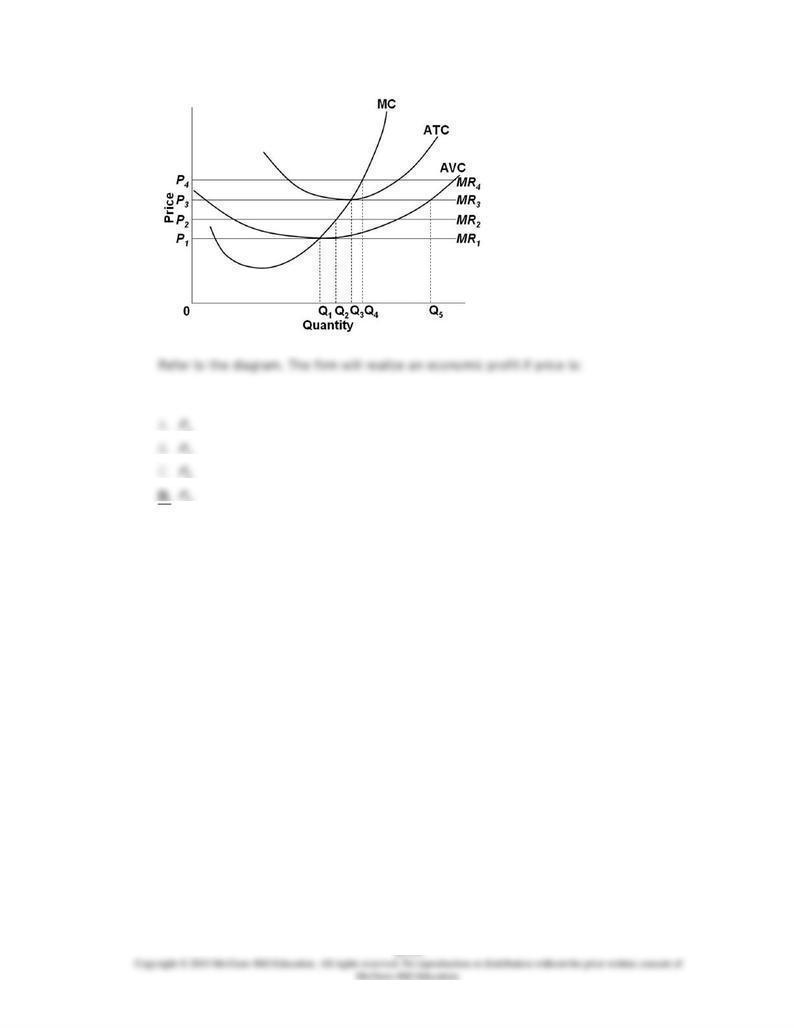
105.
1.
2.
3.
4.
AACSB: Reflective Thinking
Blooms: Apply
Difficulty: 2 Medium
Learning Objective: 10-05 Explain how purely competitive firms can use the marginal-revenue-marginal-cost approach to
maximize profits or minimize losses in the short run.
Topic: Profit maximization in the short run: marginal-revenue-marginal-cost approach
Type: Graph
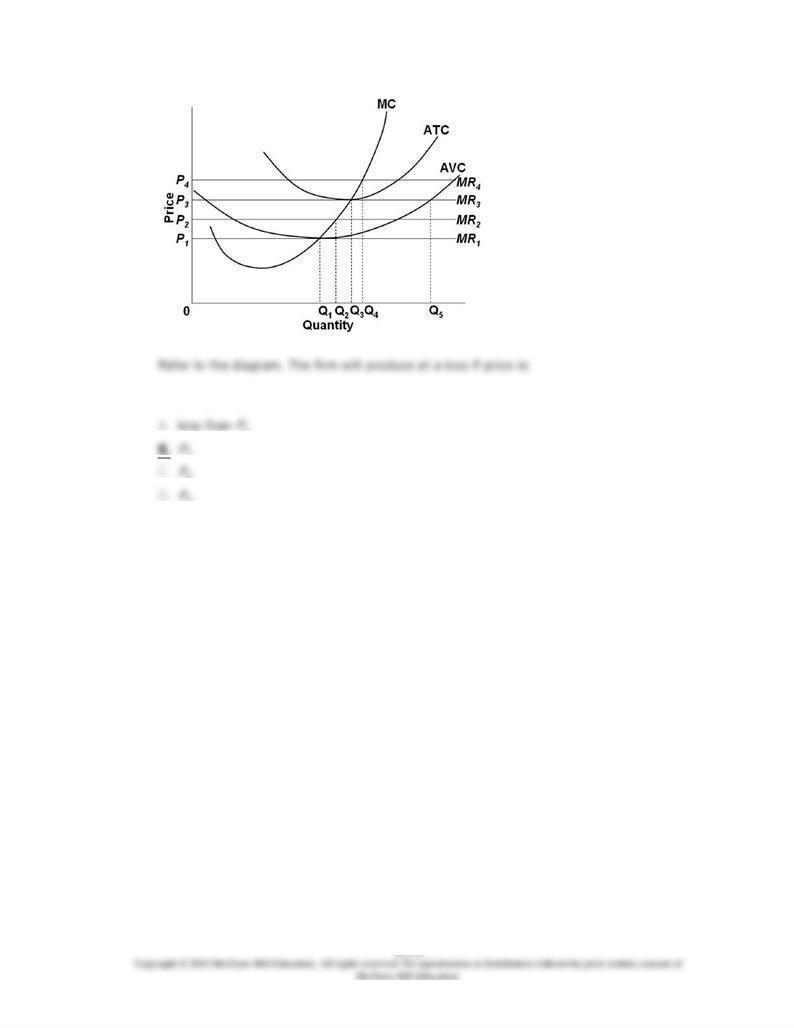
106.
1.
2.
3.
4.
AACSB: Reflective Thinking
Blooms: Apply
Difficulty: 2 Medium
Learning Objective: 10-05 Explain how purely competitive firms can use the marginal-revenue-marginal-cost approach to
maximize profits or minimize losses in the short run.
Topic: Profit maximization in the short run: marginal-revenue-marginal-cost approach
Type: Graph

107.
1.
2.
3.
4.
AACSB: Reflective Thinking
Blooms: Apply
Difficulty: 2 Medium
Learning Objective: 10-05 Explain how purely competitive firms can use the marginal-revenue-marginal-cost approach to
maximize profits or minimize losses in the short run.
Topic: Profit maximization in the short run: marginal-revenue-marginal-cost approach
Type: Graph
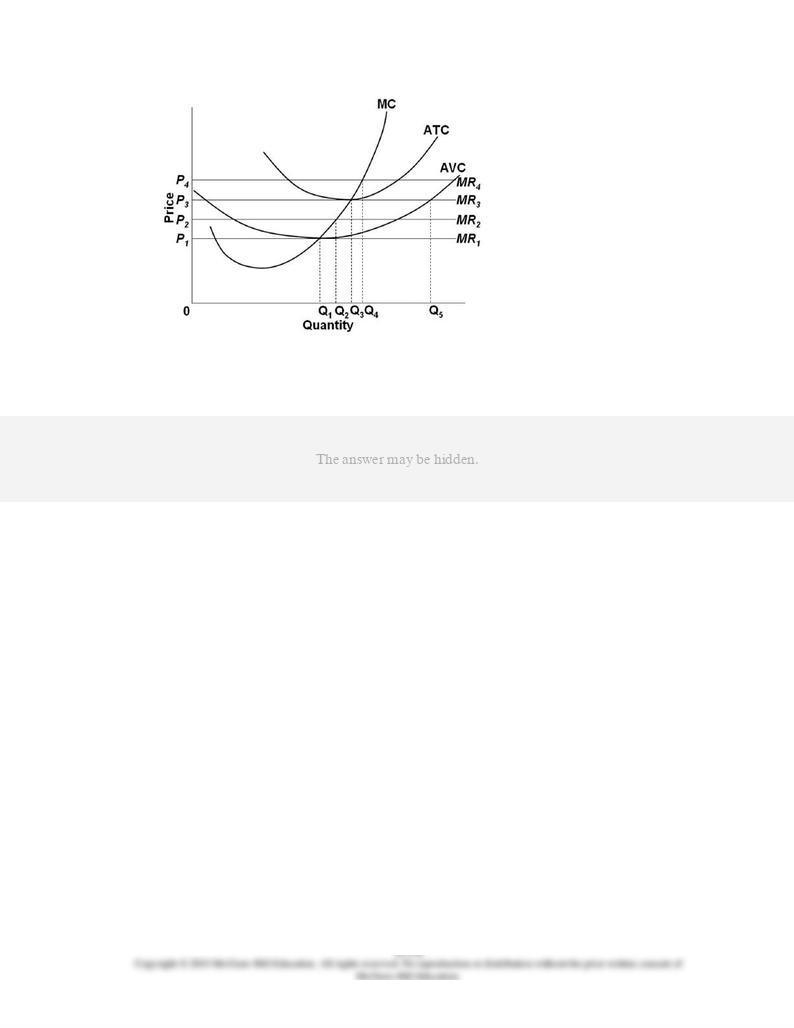
108.
Refer to the diagram. The firm's supply curve is the segment of the:
AACSB: Reflective Thinking
Blooms: Apply
Difficulty: 2 Medium
Learning Objective: 10-06 Explain why a competitive firm's marginal cost curve is the same as its supply curve.
Topic: Marginal cost and short-run supply
Type: Graph
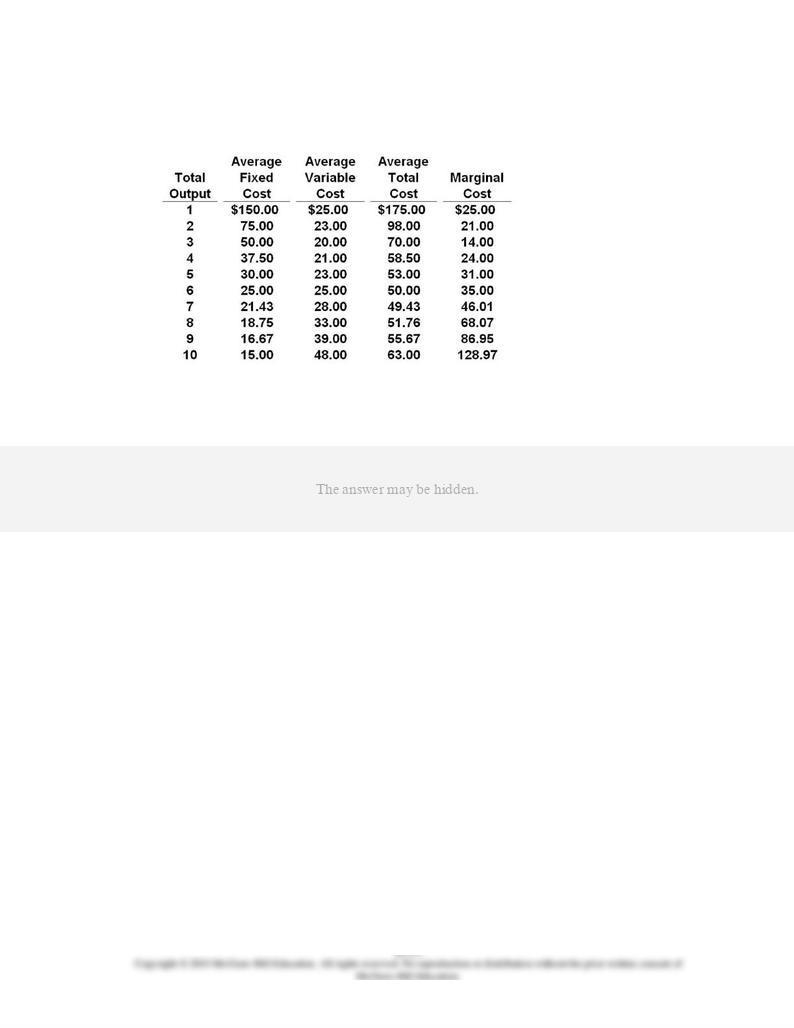
109.
Answer the question on the basis of the following cost data for a firm that is selling in a
purely competitive market.
Refer to the data. The marginal cost column reflects:
AACSB: Reflective Thinking
Blooms: Understand
Difficulty: 2 Medium
Learning Objective: 10-05 Explain how purely competitive firms can use the marginal-revenue-marginal-cost approach to
maximize profits or minimize losses in the short run.
Topic: Profit maximization in the short run: marginal-revenue-marginal-cost approach
Type: Table
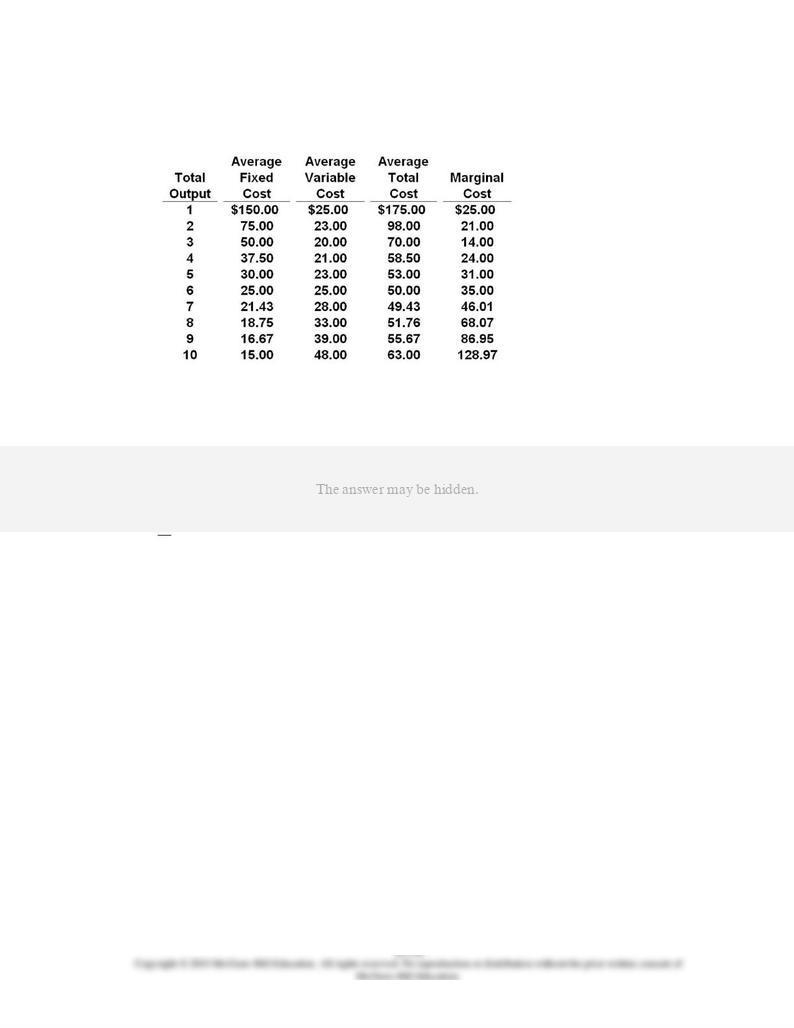
110.
Answer the question on the basis of the following cost data for a firm that is selling in a
purely competitive market.
Refer to the data. At 6 units of output, total fixed cost is ____ and total cost is ____.
AACSB: Analytic
Blooms: Apply
Difficulty: 2 Medium
Learning Objective: 10-05 Explain how purely competitive firms can use the marginal-revenue-marginal-cost approach to
maximize profits or minimize losses in the short run.
Topic: Profit maximization in the short run: marginal-revenue-marginal-cost approach
Type: Table
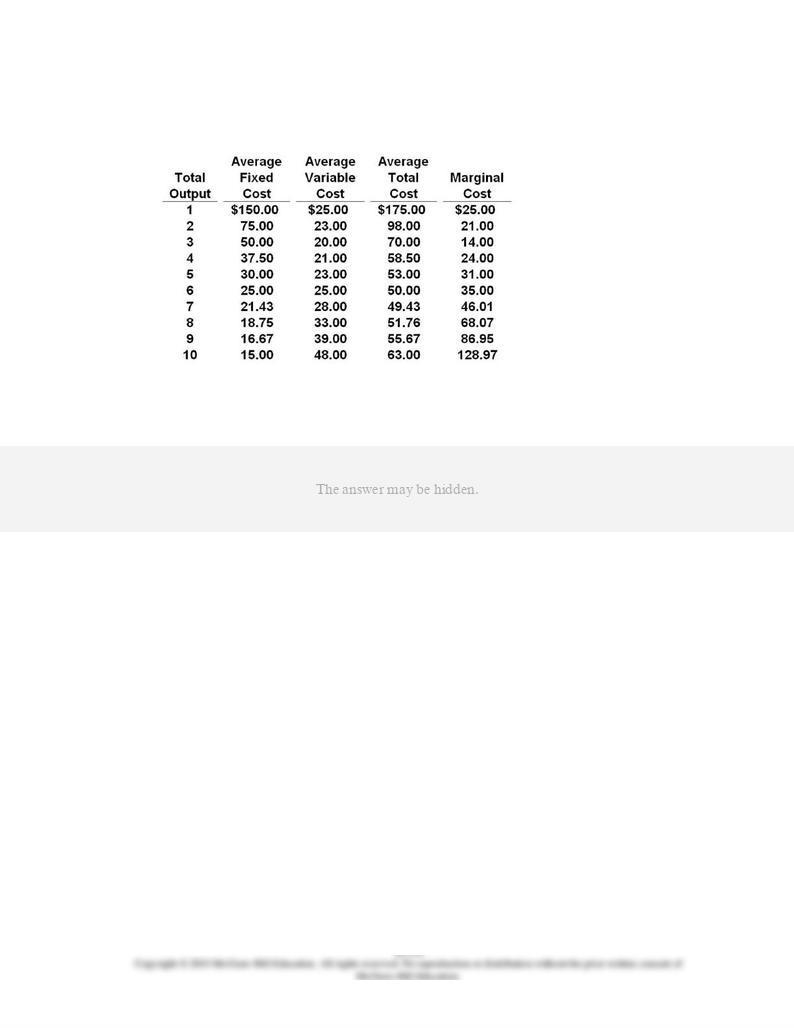
111.
Answer the question on the basis of the following cost data for a firm that is selling in a
purely competitive market.
Refer to the data. At 3 units of output, total variable cost is ____ and total cost is ____.
AACSB: Analytic
Blooms: Apply
Difficulty: 2 Medium
Learning Objective: 10-05 Explain how purely competitive firms can use the marginal-revenue-marginal-cost approach to
maximize profits or minimize losses in the short run.
Topic: Profit maximization in the short run: marginal-revenue-marginal-cost approach
Type: Table
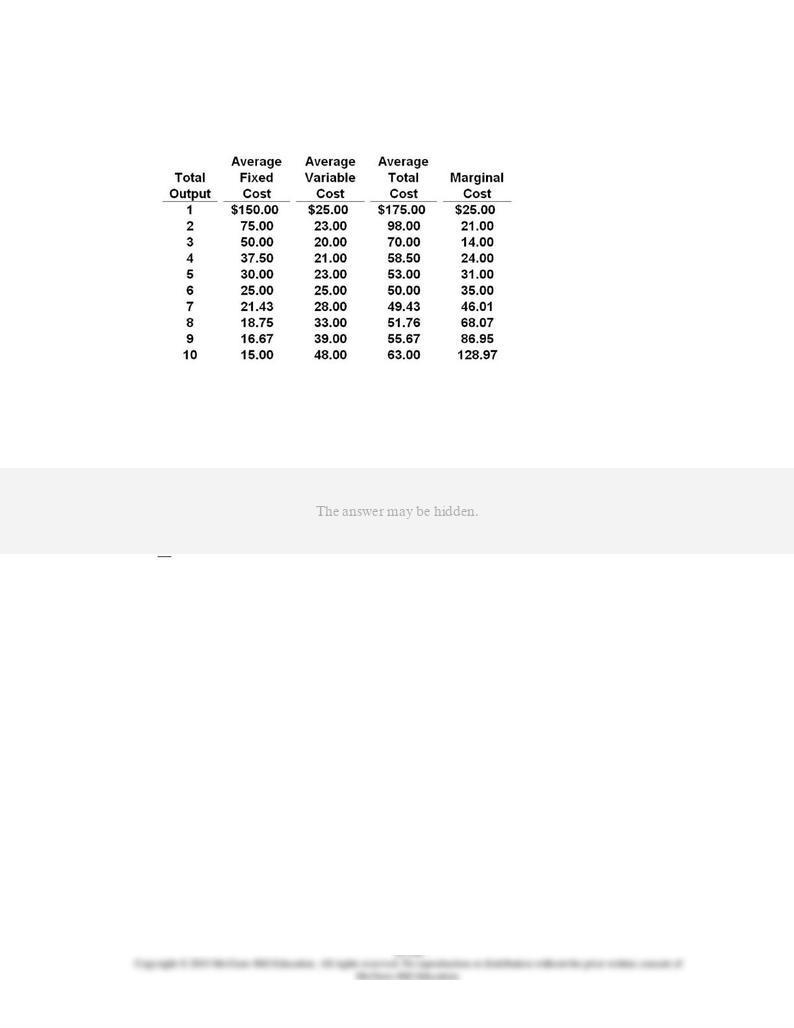
112.
Answer the question on the basis of the following cost data for a firm that is selling in a
purely competitive market.
Refer to the data. We can infer that, at zero output, this firm's
total
fixed,
total
variable,
and
total
costs are:
AACSB: Analytic
Blooms: Apply
Difficulty: 2 Medium
Learning Objective: 10-05 Explain how purely competitive firms can use the marginal-revenue-marginal-cost approach to
maximize profits or minimize losses in the short run.
Topic: Profit maximization in the short run: marginal-revenue-marginal-cost approach
Type: Table
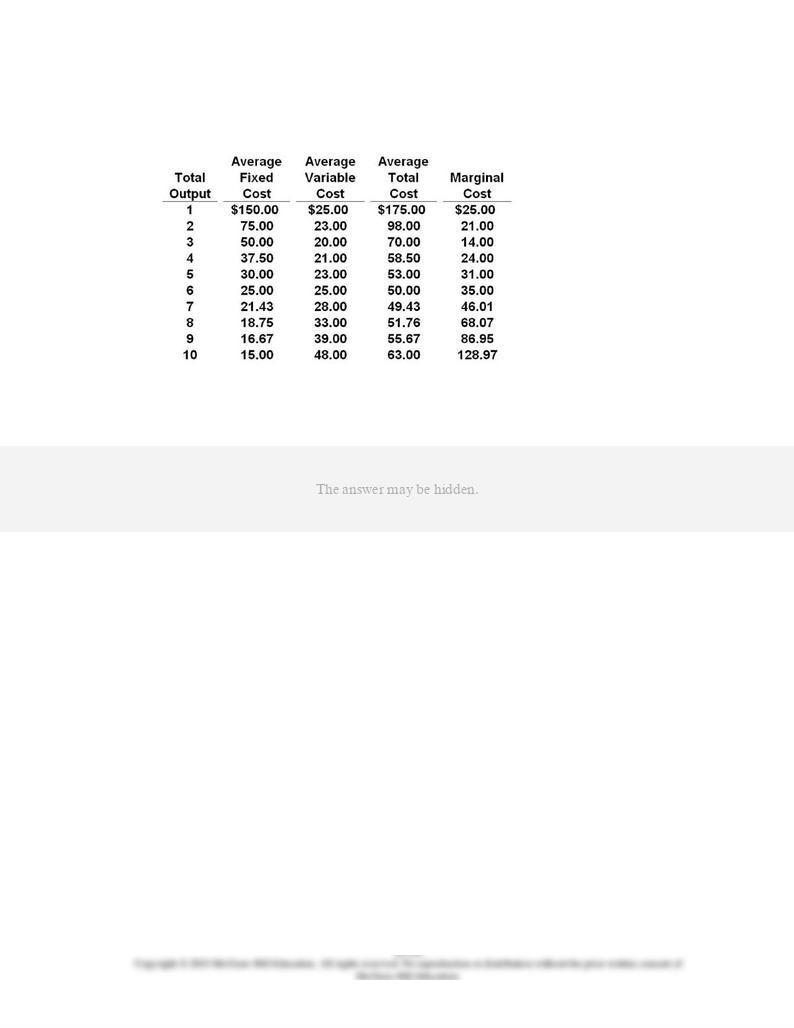
113.
Answer the question on the basis of the following cost data for a firm that is selling in a
purely competitive market.
Refer to the data. If the market price for this firm's product is $87, it will produce:
AACSB: Analytic
Blooms: Analyze
Difficulty: 3 Hard
Learning Objective: 10-05 Explain how purely competitive firms can use the marginal-revenue-marginal-cost approach to
maximize profits or minimize losses in the short run.
Topic: Profit maximization in the short run: marginal-revenue-marginal-cost approach
Type: Table
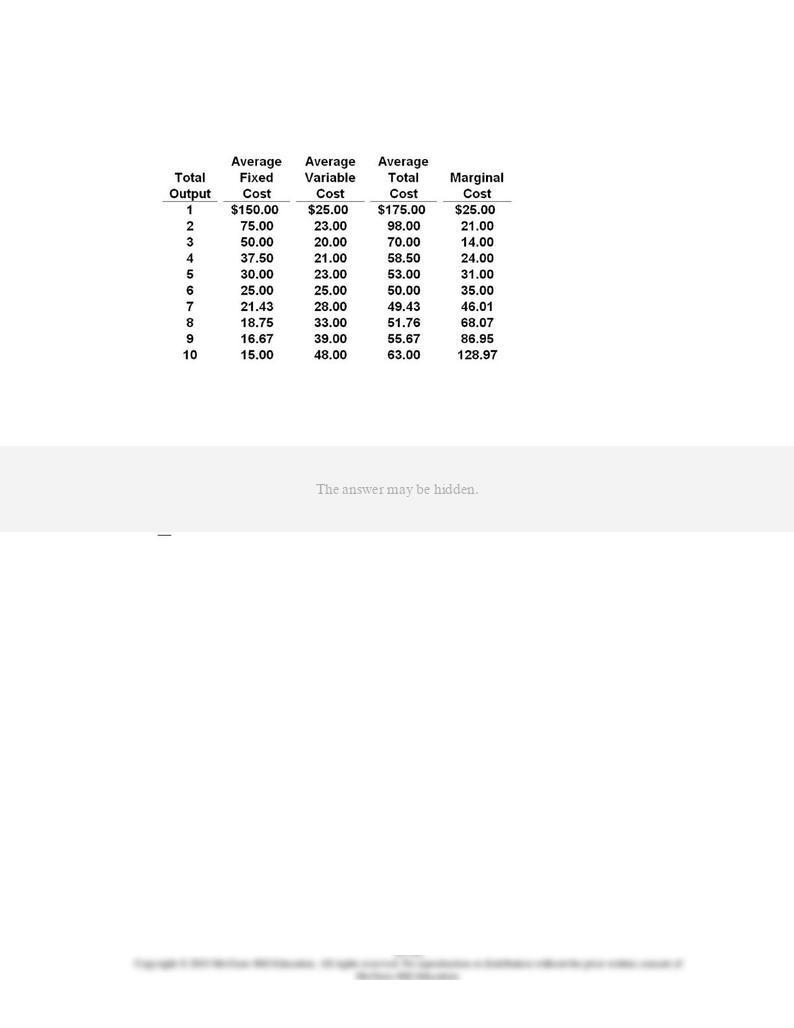
114.
Answer the question on the basis of the following cost data for a firm that is selling in a
purely competitive market.
Refer to the data. If the market price for this firm's product is $68.10, it will produce:
AACSB: Analytic
Blooms: Analyze
Difficulty: 3 Hard
Learning Objective: 10-05 Explain how purely competitive firms can use the marginal-revenue-marginal-cost approach to
maximize profits or minimize losses in the short run.
Topic: Profit maximization in the short run: marginal-revenue-marginal-cost approach
Type: Table
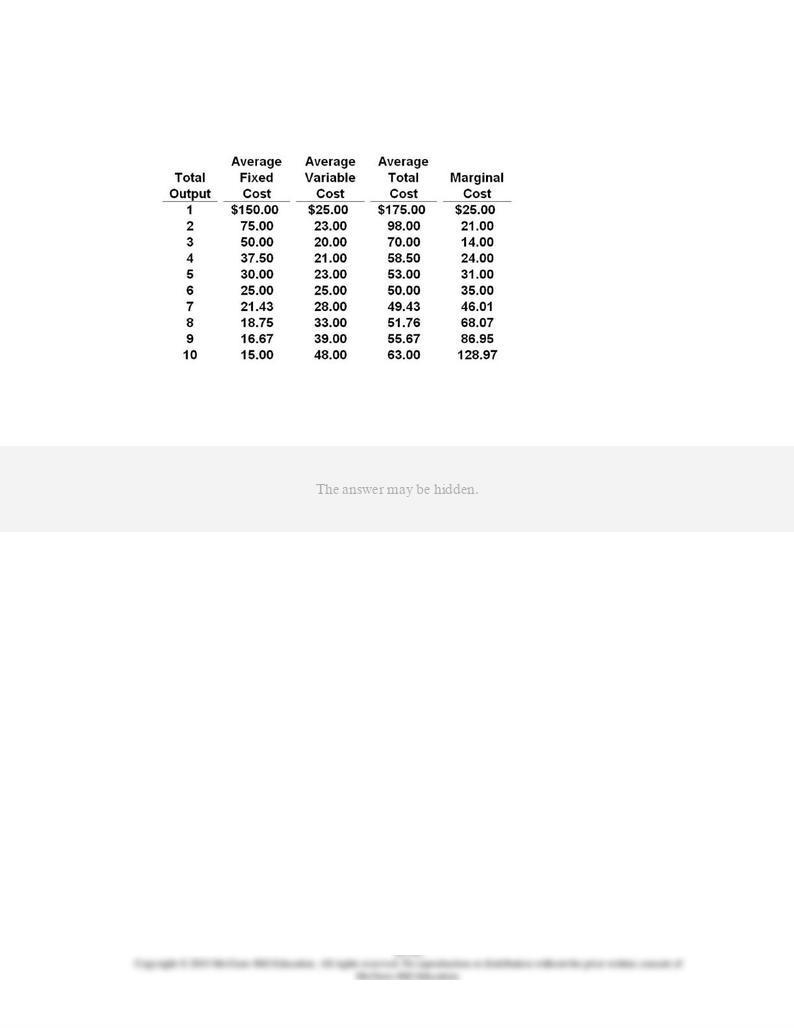
115.
Answer the question on the basis of the following cost data for a firm that is selling in a
purely competitive market.
Refer to the data. If the market price for this firm's product is $35, it will produce:
AACSB: Analytic
Blooms: Analyze
Difficulty: 3 Hard
Learning Objective: 10-05 Explain how purely competitive firms can use the marginal-revenue-marginal-cost approach to
maximize profits or minimize losses in the short run.
Topic: Profit maximization in the short run: marginal-revenue-marginal-cost approach
Type: Table
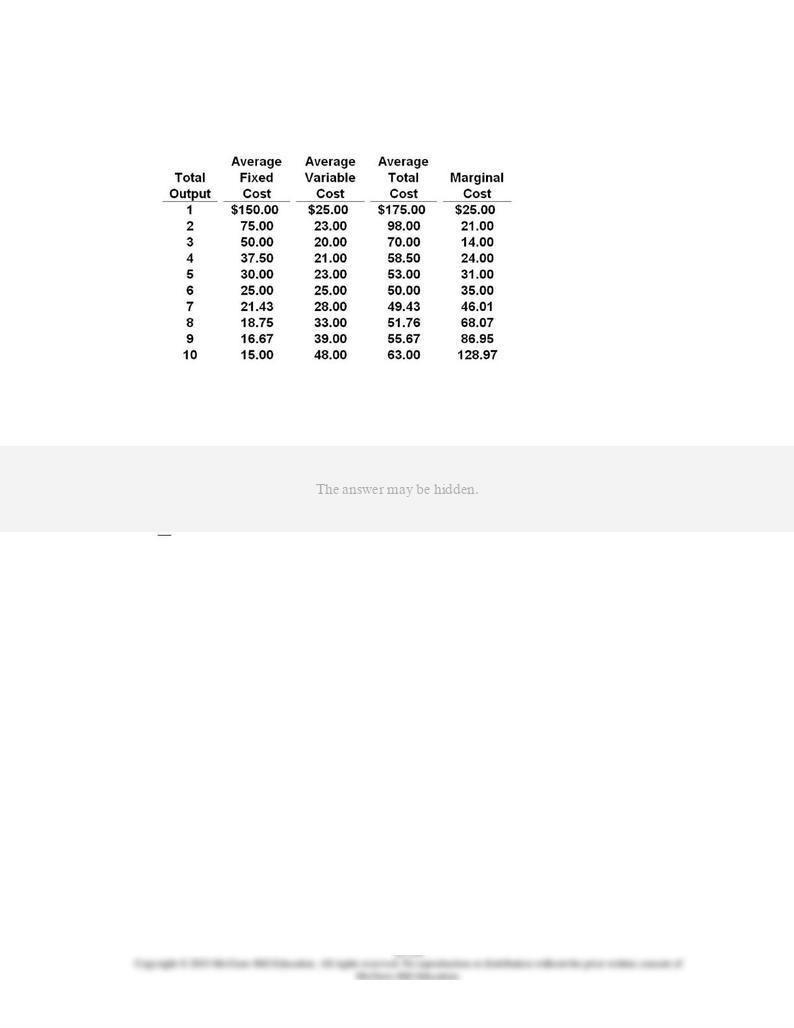
116.
Answer the question on the basis of the following cost data for a firm that is selling in a
purely competitive market.
Refer to the data. If the market price for this firm's product is $24, it will produce:
AACSB: Analytic
Blooms: Analyze
Difficulty: 3 Hard
Learning Objective: 10-05 Explain how purely competitive firms can use the marginal-revenue-marginal-cost approach to
maximize profits or minimize losses in the short run.
Topic: Profit maximization in the short run: marginal-revenue-marginal-cost approach
Type: Table

117.
Answer the question on the basis of the following cost data for a firm that is selling in a
purely competitive market.
Refer to the data. If the market price for this firm's product is $15, it will produce:
AACSB: Analytic
Blooms: Analyze
Difficulty: 3 Hard
Learning Objective: 10-05 Explain how purely competitive firms can use the marginal-revenue-marginal-cost approach to
maximize profits or minimize losses in the short run.
Topic: Profit maximization in the short run: marginal-revenue-marginal-cost approach
Type: Table
118.
A purely competitive seller should produce (rather than shut down) in the short run:
AACSB: Reflective Thinking
Accessibility: Keyboard Navigation

Blooms: Understand
Difficulty: 2 Medium
Learning Objective: 10-05 Explain how purely competitive firms can use the marginal-revenue-marginal-cost approach to
maximize profits or minimize losses in the short run.
Topic: Profit maximization in the short run: marginal-revenue-marginal-cost approach
119.
Answer the question on the basis of the following cost data for a purely competitive seller:
The data are for:
AACSB: Analytic
Blooms: Apply
Difficulty: 2 Medium
Learning Objective: 10-05 Explain how purely competitive firms can use the marginal-revenue-marginal-cost approach to
maximize profits or minimize losses in the short run.
Topic: Profit maximization in the short run: marginal-revenue-marginal-cost approach
Type: Table
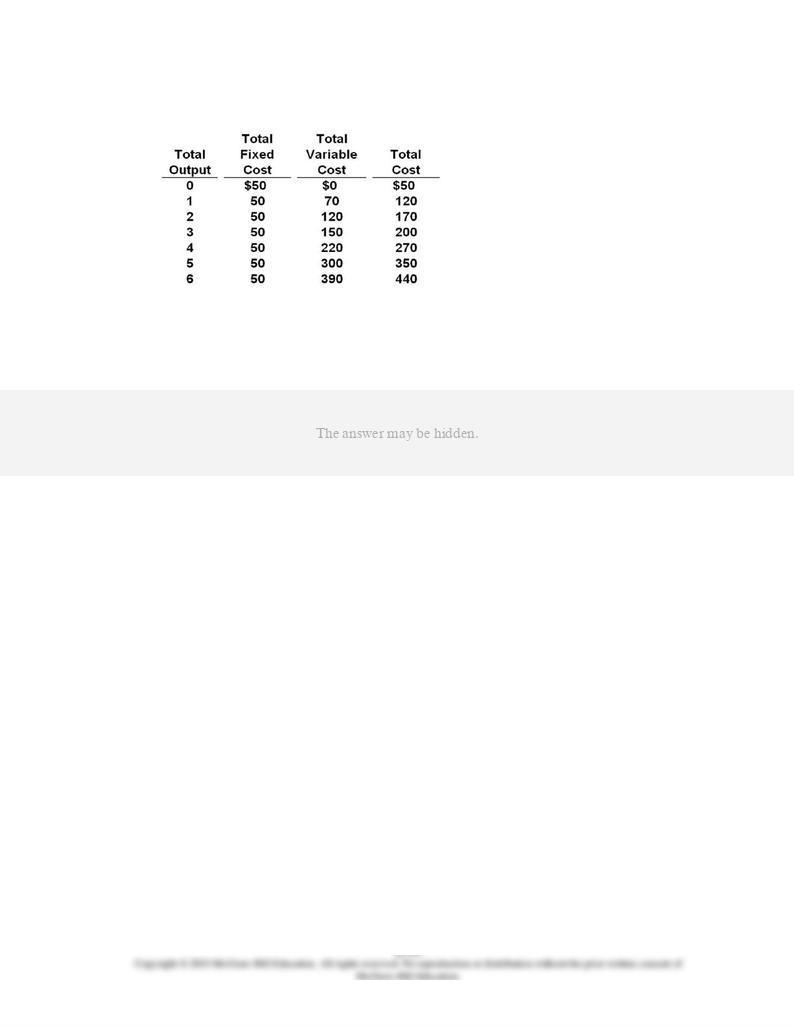
120.
Answer the question on the basis of the following cost data for a purely competitive seller:
Refer to the data. At 5 units of output, average fixed cost, average variable cost, and
average total cost are:
AACSB: Analytic
Blooms: Apply
Difficulty: 2 Medium
Learning Objective: 10-05 Explain how purely competitive firms can use the marginal-revenue-marginal-cost approach to
maximize profits or minimize losses in the short run.
Topic: Profit maximization in the short run: marginal-revenue-marginal-cost approach
Type: Table

121.
Answer the question on the basis of the following cost data for a purely competitive seller:
Refer to the data. The marginal cost of the fifth unit of output is:
AACSB: Analytic
Blooms: Apply
Difficulty: 2 Medium
Learning Objective: 10-05 Explain how purely competitive firms can use the marginal-revenue-marginal-cost approach to
maximize profits or minimize losses in the short run.
Topic: Profit maximization in the short run: marginal-revenue-marginal-cost approach
Type: Table

122.
Answer the question on the basis of the following cost data for a purely competitive seller:
Refer to the data. If product price is $75, the firm will produce:
AACSB: Analytic
Blooms: Analyze
Difficulty: 3 Hard
Learning Objective: 10-05 Explain how purely competitive firms can use the marginal-revenue-marginal-cost approach to
maximize profits or minimize losses in the short run.
Topic: Profit maximization in the short run: marginal-revenue-marginal-cost approach
Type: Table

123.
Answer the question on the basis of the following cost data for a purely competitive seller:
Refer to the data. Given the $75 product price, at its optimal output the firm will:
AACSB: Analytic
Blooms: Analyze
Difficulty: 3 Hard
Learning Objective: 10-05 Explain how purely competitive firms can use the marginal-revenue-marginal-cost approach to
maximize profits or minimize losses in the short run.
Topic: Profit maximization in the short run: marginal-revenue-marginal-cost approach
Type: Table
124.
In the short run, a purely competitive firm will earn a normal profit when:
AACSB: Reflective Thinking
Accessibility: Keyboard Navigation
Blooms: Understand
Difficulty: 2 Medium
Learning Objective: 10-05 Explain how purely competitive firms can use the marginal-revenue-marginal-cost approach to
maximize profits or minimize losses in the short run.
Topic: Profit maximization in the short run: marginal-revenue-marginal-cost approach
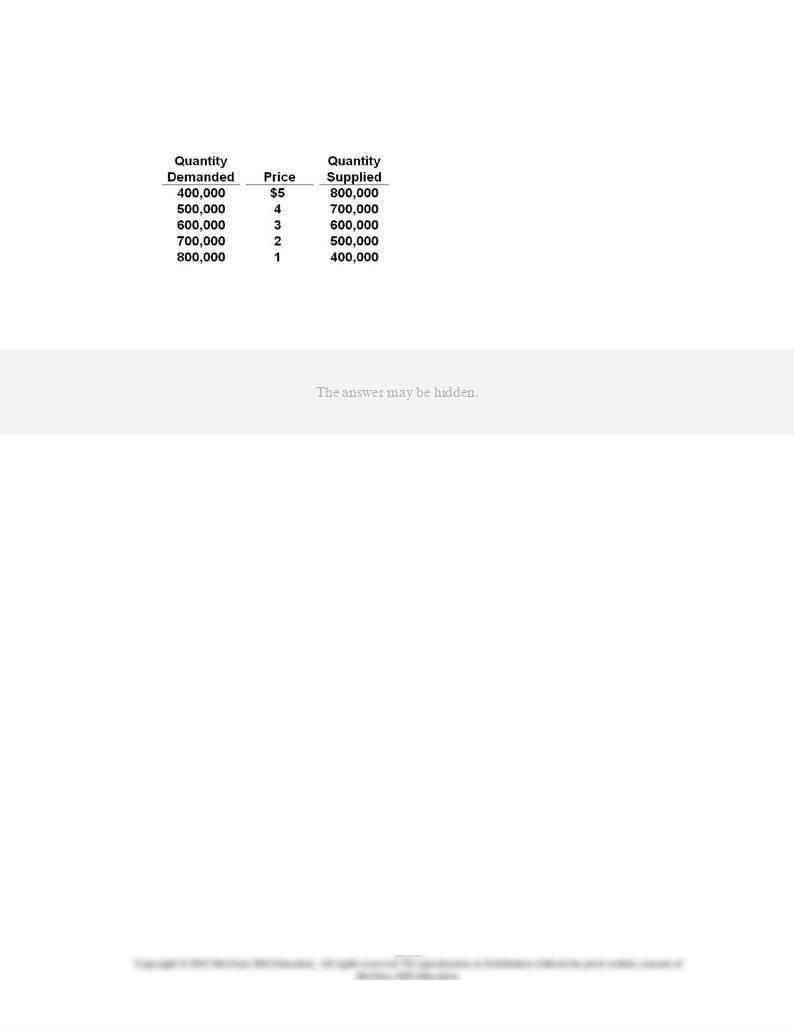
125.
The following table applies to a purely competitive industry composed of 100 identical
firms.
Refer to the table. The equilibrium price in this purely competitive market is:
AACSB: Analytic
Blooms: Analyze
Difficulty: 3 Hard
Learning Objective: 10-05 Explain how purely competitive firms can use the marginal-revenue-marginal-cost approach to
maximize profits or minimize losses in the short run.
Topic: Profit maximization in the short run: marginal-revenue-marginal-cost approach
Type: Table

126.
The following table applies to a purely competitive industry composed of 100 identical
firms.
Refer to the table. At the equilibrium price, each of the 100 firms in this industry will
produce:
AACSB: Analytic
Blooms: Analyze
Difficulty: 3 Hard
Learning Objective: 10-05 Explain how purely competitive firms can use the marginal-revenue-marginal-cost approach to
maximize profits or minimize losses in the short run.
Topic: Profit maximization in the short run: marginal-revenue-marginal-cost approach
Type: Table
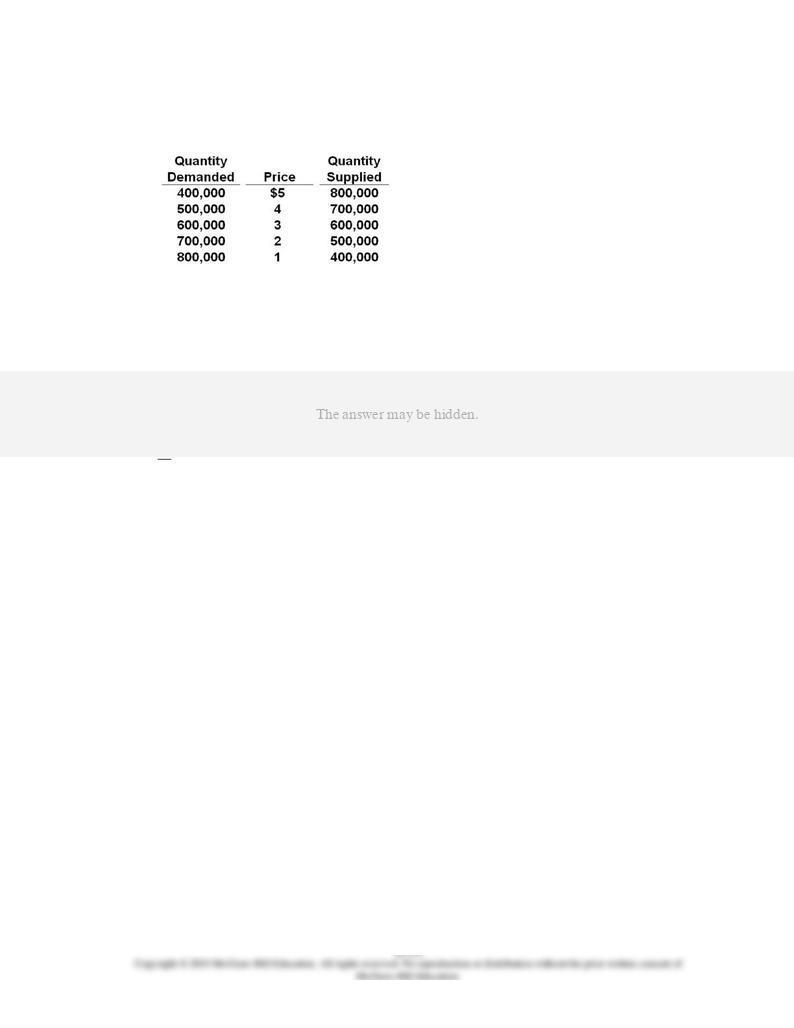
127.
The following table applies to a purely competitive industry composed of 100 identical
firms.
Refer to the table. For each of the 100 firms in this industry, marginal revenue and total
revenue will be:
AACSB: Analytic
Blooms: Analyze
Difficulty: 3 Hard
Learning Objective: 10-05 Explain how purely competitive firms can use the marginal-revenue-marginal-cost approach to
maximize profits or minimize losses in the short run.
Topic: Profit maximization in the short run: marginal-revenue-marginal-cost approach
Type: Table
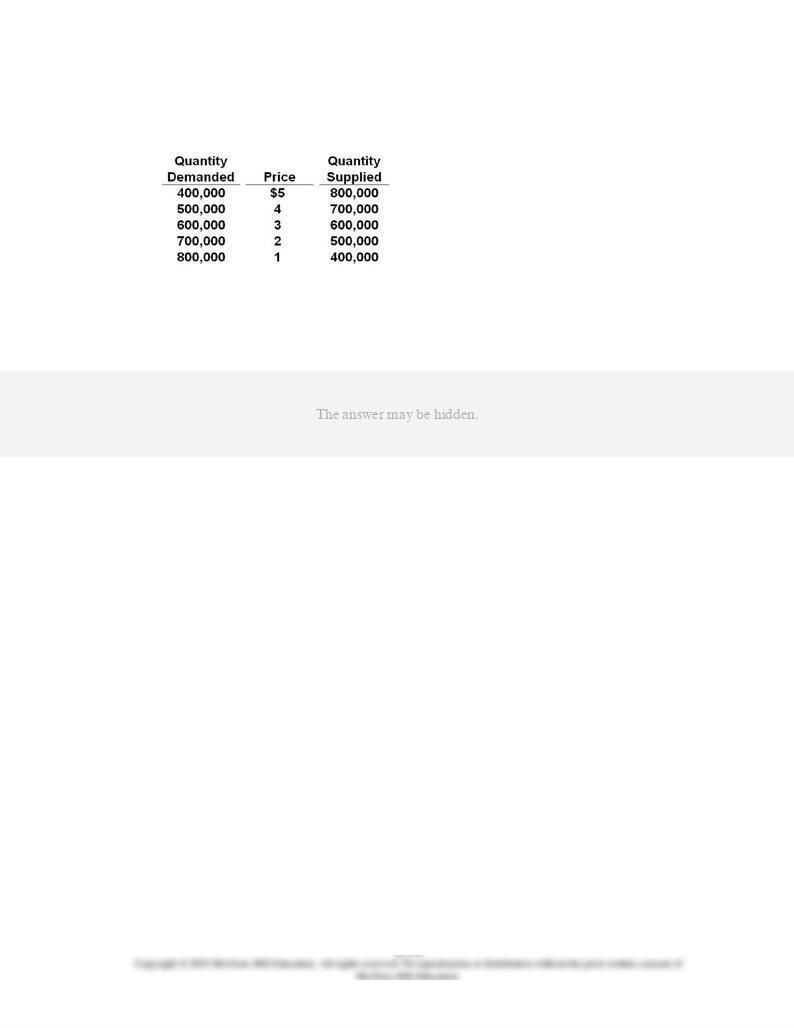
128.
The following table applies to a purely competitive industry composed of 100 identical
firms.
Refer to the table. If each of the 100 firms in the industry is maximizing its profit, each
must have a marginal cost of:
AACSB: Analytic
Blooms: Analyze
Difficulty: 3 Hard
Learning Objective: 10-05 Explain how purely competitive firms can use the marginal-revenue-marginal-cost approach to
maximize profits or minimize losses in the short run.
Topic: Profit maximization in the short run: marginal-revenue-marginal-cost approach
Type: Table
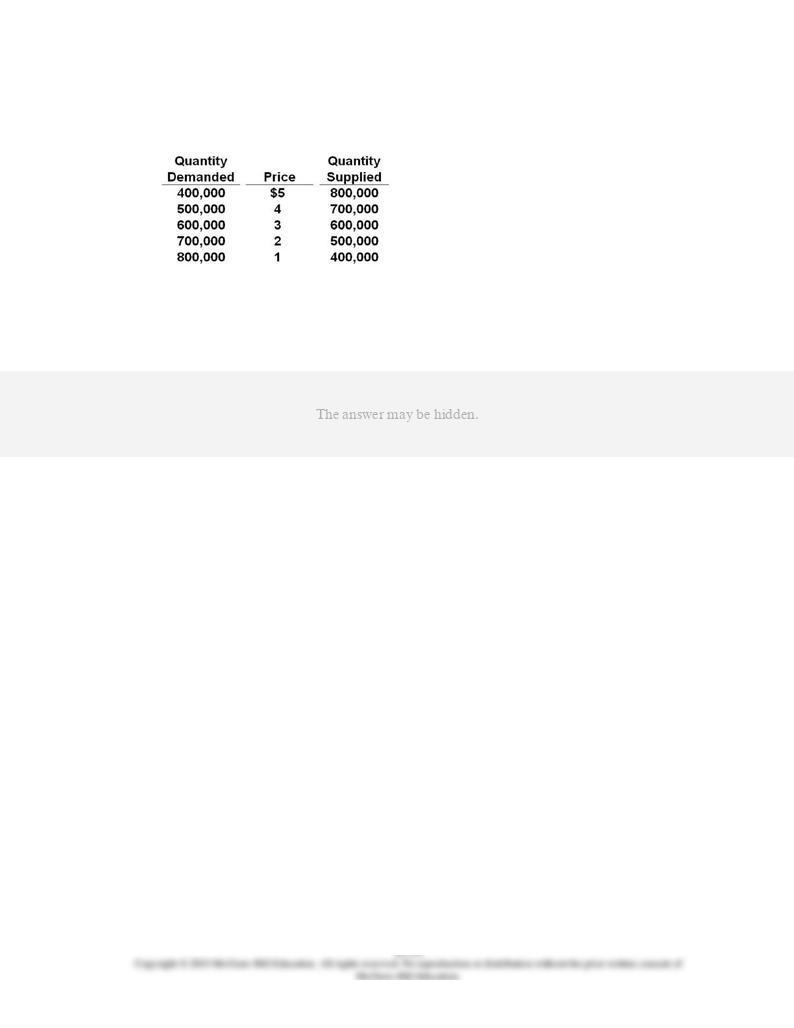
129.
The following table applies to a purely competitive industry composed of 100 identical
firms.
Refer to the table. If each of the 100 firms in the industry is maximizing its profit and
earning only a normal profit, each must have a total cost of:
AACSB: Analytic
Blooms: Analyze
Difficulty: 3 Hard
Learning Objective: 10-05 Explain how purely competitive firms can use the marginal-revenue-marginal-cost approach to
maximize profits or minimize losses in the short run.
Topic: Profit maximization in the short run: marginal-revenue-marginal-cost approach
Type: Table
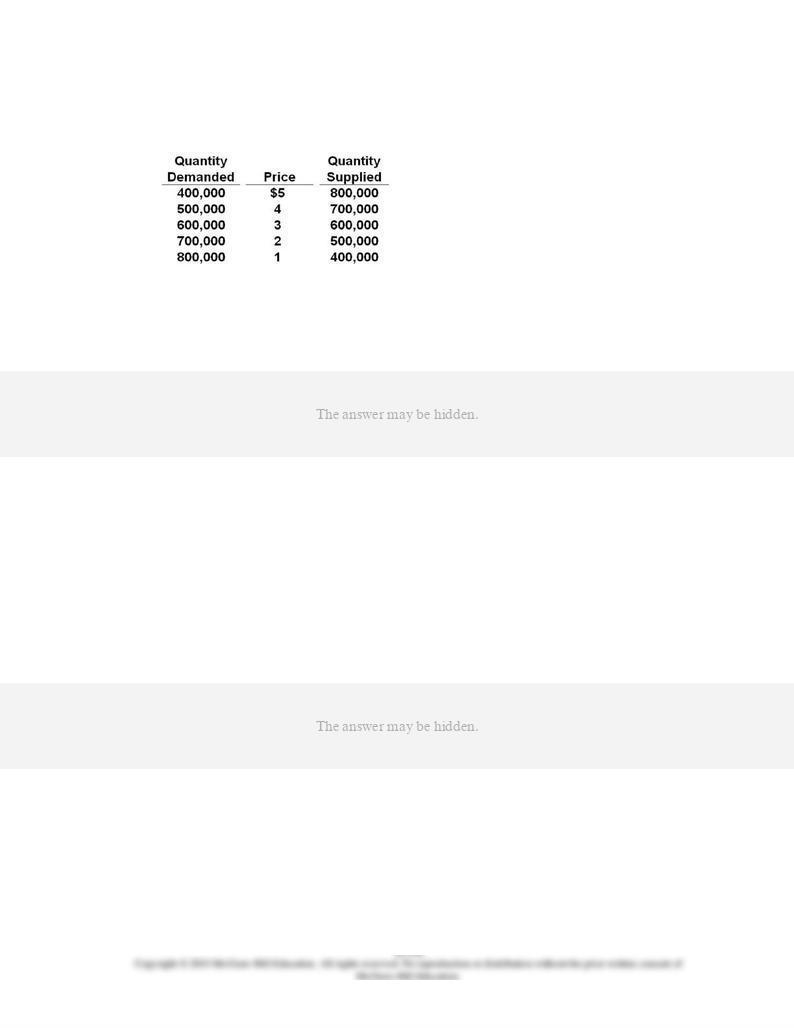
130.
The following table applies to a purely competitive industry composed of 100 identical
firms.
Refer to the table. If each of the 100 firms in the industry is maximizing its profit and
earning only a normal profit, each must have an average total cost of:
AACSB: Analytic
Blooms: Analyze
Difficulty: 3 Hard
Learning Objective: 10-05 Explain how purely competitive firms can use the marginal-revenue-marginal-cost approach to
maximize profits or minimize losses in the short run.
Topic: Profit maximization in the short run: marginal-revenue-marginal-cost approach
Type: Table
131.
(Consider This) An unprofitable motel will stay open in the short run if:
AACSB: Reflective Thinking
Accessibility: Keyboard Navigation
Blooms: Apply
Difficulty: 2 Medium
Learning Objective: 10-05 Explain how purely competitive firms can use the marginal-revenue-marginal-cost approach to
maximize profits or minimize losses in the short run.
Topic: Profit maximization in the short run: marginal-revenue-marginal-cost approach

132.
(Consider This) An otherwise unprofitable motel located on a largely abandoned roadway
might be able to stay open for several years by:
AACSB: Reflective Thinking
Accessibility: Keyboard Navigation
Blooms: Apply
Difficulty: 2 Medium
Learning Objective: 10-05 Explain how purely competitive firms can use the marginal-revenue-marginal-cost approach to
maximize profits or minimize losses in the short run.
Topic: Profit maximization in the short run: marginal-revenue-marginal-cost approach
133.
(Last Word) Fixed costs for a firm are analogous to:
AACSB: Analytic
Accessibility: Keyboard Navigation
Blooms: Understand
Difficulty: 2 Medium
Learning Objective: 10-05 Explain how purely competitive firms can use the marginal-revenue-marginal-cost approach to
maximize profits or minimize losses in the short run.
Topic: Profit maximization in the short run: marginal-revenue-marginal-cost approach
134.
(Last Word) Oil wells and seasonal resorts will often shut down temporarily because:
AACSB: Analytic

Accessibility: Keyboard Navigation
Blooms: Remember
Difficulty: 1 Easy
Learning Objective: 10-05 Explain how purely competitive firms can use the marginal-revenue-marginal-cost approach to
maximize profits or minimize losses in the short run.
Topic: Profit maximization in the short run: marginal-revenue-marginal-cost approach
135.
(Last Word) Temporary shutdowns of firms are most widespread when:
AACSB: Analytic
Accessibility: Keyboard Navigation
Blooms: Remember
Difficulty: 1 Easy
Learning Objective: 10-05 Explain how purely competitive firms can use the marginal-revenue-marginal-cost approach to
maximize profits or minimize losses in the short run.
Topic: Profit maximization in the short run: marginal-revenue-marginal-cost approach
True / False Questions
136.
Oligopoly firms may produce either standardized or differentiated products.
AACSB: Analytic
Accessibility: Keyboard Navigation
Blooms: Remember
Difficulty: 1 Easy
Learning Objective: 10-01 Give the names and summarize the main characteristics of the four basic market models.
Topic: Four market models

137.
The term
imperfect
competition
refers to every market structure besides pure
competition.
AACSB: Analytic
Accessibility: Keyboard Navigation
Blooms: Remember
Difficulty: 1 Easy
Learning Objective: 10-01 Give the names and summarize the main characteristics of the four basic market models.
Topic: Four market models
138.
Firms in a monopolistically competitive industry have no reason to engage in nonprice
competition because their products are uniquely different from other sellers in the
market.
AACSB: Analytic
Accessibility: Keyboard Navigation
Blooms: Remember
Difficulty: 1 Easy
Learning Objective: 10-01 Give the names and summarize the main characteristics of the four basic market models.
Topic: Four market models
139.
Although individual purely competitive firms can influence the price of their product, these
firms as a group cannot influence market price.
AACSB: Analytic
Accessibility: Keyboard Navigation
Blooms: Remember
Difficulty: 1 Easy
Learning Objective: 10-02 List the conditions required for purely competitive markets.
Topic: Pure competition: characteristics and occurrence
140.
In a purely competitive industry competition centers more on advertising and sales
promotion than on price.
AACSB: Analytic
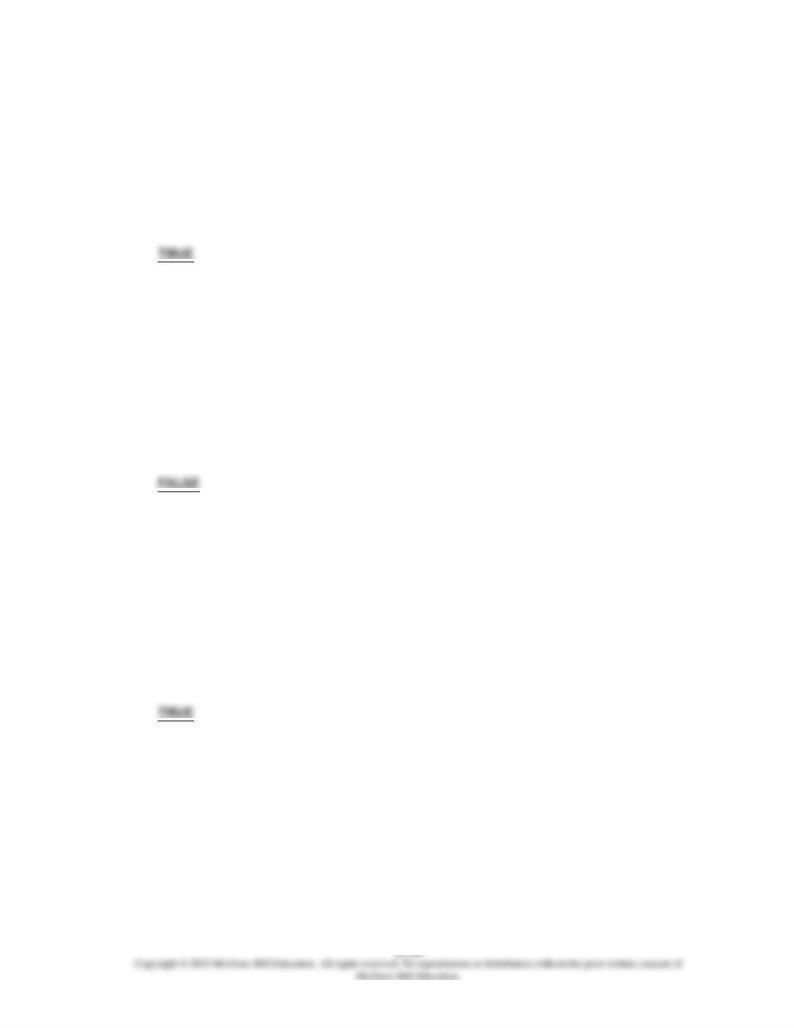
Accessibility: Keyboard Navigation
Blooms: Remember
Difficulty: 1 Easy
Learning Objective: 10-02 List the conditions required for purely competitive markets.
Topic: Pure competition: characteristics and occurrence
141.
Price and marginal revenue are identical for an individual purely competitive seller.
AACSB: Analytic
Accessibility: Keyboard Navigation
Blooms: Remember
Difficulty: 1 Easy
Learning Objective: 10-03 Explain how demand is seen by a purely competitive seller.
Topic: Demand as seen by a purely competitive seller
142.
The demand curve for a purely competitive industry is perfectly elastic, but the demand
curves faced by individual firms in such an industry are downsloping.
AACSB: Analytic
Accessibility: Keyboard Navigation
Blooms: Remember
Difficulty: 1 Easy
Learning Objective: 10-03 Explain how demand is seen by a purely competitive seller.
Topic: Demand as seen by a purely competitive seller
143.
Marginal revenue is the addition to total revenue resulting from the sale of one more unit
of output.
AACSB: Analytic
Accessibility: Keyboard Navigation
Blooms: Remember
Difficulty: 1 Easy
Learning Objective: 10-03 Explain how demand is seen by a purely competitive seller.
Topic: Demand as seen by a purely competitive seller

144.
In maximizing profit, a firm will always produce that output where total revenues are at a
maximum.
AACSB: Analytic
Accessibility: Keyboard Navigation
Blooms: Remember
Difficulty: 1 Easy
Learning Objective: 10-04 Convey how purely competitive firms can use the total-revenue-total-cost approach to
maximize profits or minimize losses in the short run.
Topic: Profit maximization in the short run: total-revenue-total-cost approach
145.
In the short run, a competitive firm will always choose to shut down if product price is less
than the lowest attainable average total cost.
AACSB: Reflective Thinking
Accessibility: Keyboard Navigation
Blooms: Understand
Difficulty: 2 Medium
Learning Objective: 10-05 Explain how purely competitive firms can use the marginal-revenue-marginal-cost approach to
maximize profits or minimize losses in the short run.
Topic: Profit maximization in the short run: marginal-revenue-marginal-cost approach
146.
A competitive firm will produce in the short run so long as its price exceeds its average
fixed cost.
AACSB: Reflective Thinking
Accessibility: Keyboard Navigation
Blooms: Understand
Difficulty: 2 Medium
Learning Objective: 10-05 Explain how purely competitive firms can use the marginal-revenue-marginal-cost approach to
maximize profits or minimize losses in the short run.
Topic: Profit maximization in the short run: marginal-revenue-marginal-cost approach
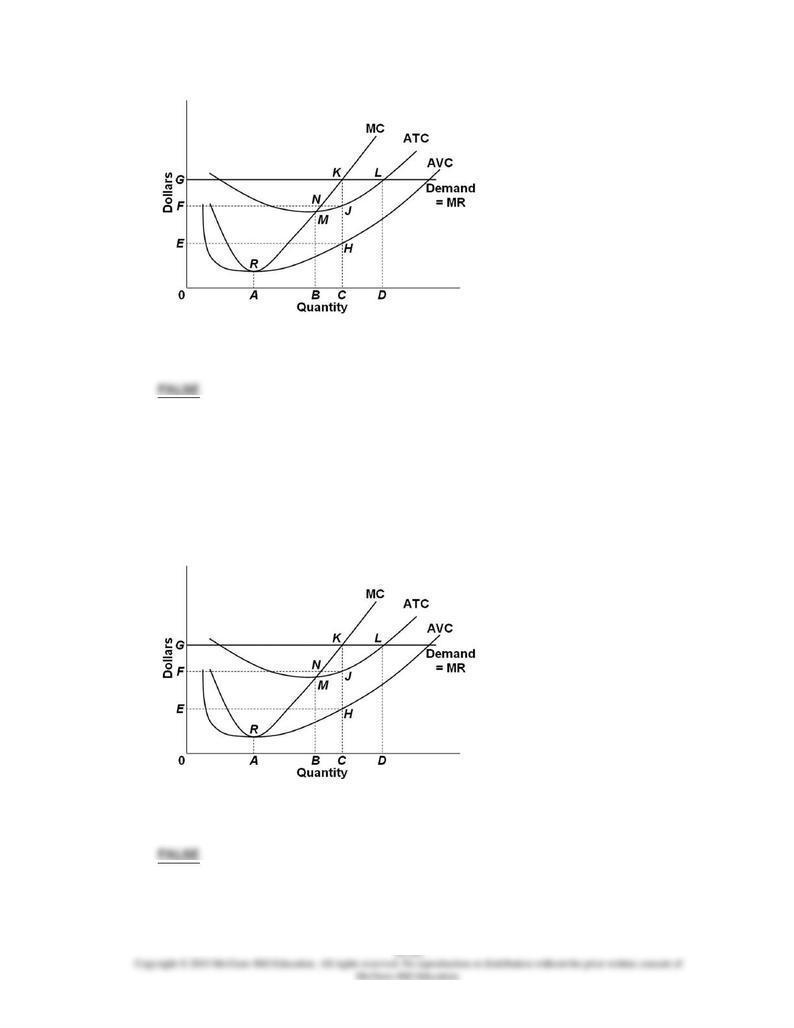
147.
Refer to the diagram. This firm will maximize profits by producing output
D
.
AACSB: Reflective Thinking
Blooms: Analyze
Difficulty: 3 Hard
Learning Objective: 10-05 Explain how purely competitive firms can use the marginal-revenue-marginal-cost approach to
maximize profits or minimize losses in the short run.
Topic: Profit maximization in the short run: marginal-revenue-marginal-cost approach
Type: Graph
148.
Refer to the diagram. At the profit-maximizing output, total revenue will be 0
GLD
.
AACSB: Reflective Thinking
Blooms: Analyze

Difficulty: 3 Hard
Learning Objective: 10-05 Explain how purely competitive firms can use the marginal-revenue-marginal-cost approach to
maximize profits or minimize losses in the short run.
Topic: Profit maximization in the short run: marginal-revenue-marginal-cost approach
Type: Graph
149.
Refer to the diagram. At output
C
production will result in an economic profit.
AACSB: Reflective Thinking
Blooms: Apply
Difficulty: 2 Medium
Learning Objective: 10-05 Explain how purely competitive firms can use the marginal-revenue-marginal-cost approach to
maximize profits or minimize losses in the short run.
Topic: Profit maximization in the short run: marginal-revenue-marginal-cost approach
Type: Graph

150.
Refer to the diagram. At any price below
R
the firm will shut down in the short run.
AACSB: Reflective Thinking
Blooms: Apply
Difficulty: 2 Medium
Learning Objective: 10-05 Explain how purely competitive firms can use the marginal-revenue-marginal-cost approach to
maximize profits or minimize losses in the short run.
Topic: Profit maximization in the short run: marginal-revenue-marginal-cost approach
Type: Graph
151.
Refer to the diagram. If demand fell to the level of
FNJ
, there would be no output at which
the firm could realize an economic profit.
AACSB: Reflective Thinking

Blooms: Apply
Difficulty: 2 Medium
Learning Objective: 10-05 Explain how purely competitive firms can use the marginal-revenue-marginal-cost approach to
maximize profits or minimize losses in the short run.
Topic: Profit maximization in the short run: marginal-revenue-marginal-cost approach
Type: Graph
152.
Refer to the diagram. If the firm produced
D
units of output at price
G
, it would earn a
normal profit.
AACSB: Reflective Thinking
Blooms: Apply
Difficulty: 2 Medium
Learning Objective: 10-05 Explain how purely competitive firms can use the marginal-revenue-marginal-cost approach to
maximize profits or minimize losses in the short run.
Topic: Profit maximization in the short run: marginal-revenue-marginal-cost approach
Type: Graph
153.
The short-run supply curve slopes upward because producers must be compensated for
rising marginal costs.
AACSB: Reflective Thinking
Accessibility: Keyboard Navigation
Blooms: Understand
Difficulty: 2 Medium
Learning Objective: 10-06 Explain why a competitive firm's marginal cost curve is the same as its supply curve.
Topic: Marginal cost and short-run supply
